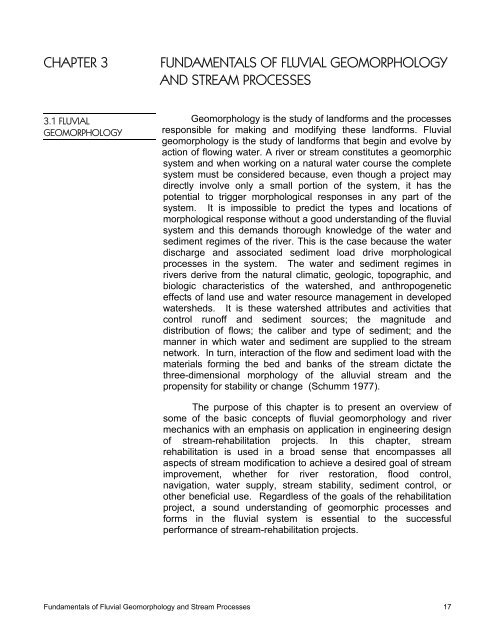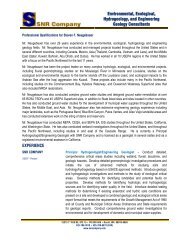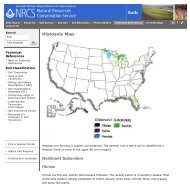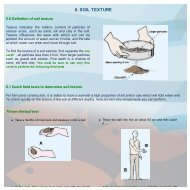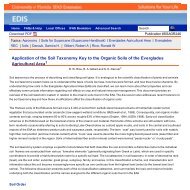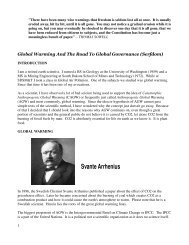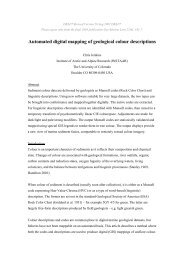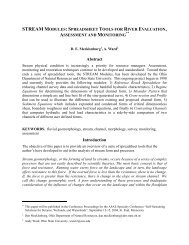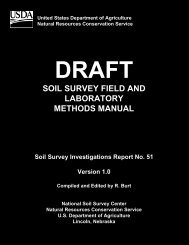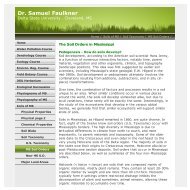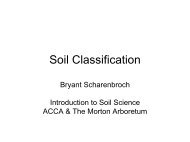chapter 3 fundamentals of fluvial geomorphology and stream ...
chapter 3 fundamentals of fluvial geomorphology and stream ...
chapter 3 fundamentals of fluvial geomorphology and stream ...
You also want an ePaper? Increase the reach of your titles
YUMPU automatically turns print PDFs into web optimized ePapers that Google loves.
materials. Also, the threshold mobility index is not single valued,but is better characterized by a stochastically determined range <strong>of</strong>values (Figure 3.2). These findings illustrate that in practice, thegeomorphic threshold behavior <strong>of</strong> alluvial <strong>stream</strong>s may becomplex.0.1BraidedIncisingMe<strong>and</strong>eringFigure 3.2 – Probability (%) <strong>of</strong>Incising or Braiding as aFunction <strong>of</strong> SQ 0.5 <strong>and</strong> D 50 forStreams with S<strong>and</strong> Beds --Discharge is Represented byAnnual Flood as First Prioritythen Bankfull (from Bledsoe <strong>and</strong>Watson 2001)0.010.00190%70%50%30%10%0.1 1D50 (mm)3.2.5 TimeWe all have been exposed to the geologist’s view <strong>of</strong> time.The Paleozoic Era ended only 248 million years ago, the MesozoicEra ended only 65 million years ago, <strong>and</strong> so on. Fortunately, wedo not have to concern ourselves with that terminology. Anaquatic biologist may be concerned with the duration <strong>of</strong> an insectlife stage, only a few hours or days. What we should be aware <strong>of</strong>is that the geologist’s temporal perspective is much broader thanthe temporal perspective <strong>of</strong> the engineer, <strong>and</strong> the biologist’sperspective may be a narrowly focused time scale. Neitherpr<strong>of</strong>ession is good nor bad because <strong>of</strong> the temporal perspective;just remember the background <strong>of</strong> people or the literature withwhich you are working.Geomorphologists usually refer to three time scales inworking with rivers: 1) geologic time, 2) modern time, <strong>and</strong> 3)present time. Geologic time is usually expressed in thous<strong>and</strong>s ormillions <strong>of</strong> years, <strong>and</strong> in this time scale only major geologic activitywould be significant. Formation <strong>of</strong> mountain ranges, changes insea level, <strong>and</strong> climate change would be significant in this timescale. The modern time scale describes a period <strong>of</strong> tens <strong>of</strong> yearsto several hundred years, <strong>and</strong> has been called the graded timescale (Schumm <strong>and</strong> Lichty 1965). During this period, a river mayadjust to a balanced condition, adjusting to watershed water <strong>and</strong>sediment discharge. The present time is considered a shorterperiod, perhaps one year to ten years. No fixed rules govern thesedefinitions. Design <strong>of</strong> a major project may require less than ten22 Fundamentals <strong>of</strong> Fluvial Geomorphology <strong>and</strong> Stream Processes
years, <strong>and</strong> numerous minor projects are designed <strong>and</strong> built withinthe limitations <strong>of</strong> present time (1 to 10 years). Project life <strong>of</strong>tenextends into graded time. From a geologist’s temporal point <strong>of</strong>view, engineers build major projects in an instant <strong>of</strong> time, basetheir design on data collected during a very brief period, <strong>and</strong>expect the projects to last for a significant period in a dynamicallychanging system.In river-related projects, time is the enemy, <strong>and</strong> time can beour friend <strong>and</strong> teacher. Recognition <strong>of</strong> the importance <strong>of</strong> time isespecially important when considering the post-constructionperformance <strong>of</strong> a project. Society dem<strong>and</strong>s a quick return <strong>of</strong>investments <strong>and</strong> the projects are expected to produce positiveresults almost instantaneously. Often, success or failure <strong>of</strong> aproject is judged within one or two years, regardless <strong>of</strong> whetherformative events have occurred to drive geomorphic recovery fromconstruction impacts, or design events have occurred to testwhether the project works as it was intended. With respect to themorphological impacts <strong>of</strong> a river-engineering project, it must beremembered that short-term <strong>stream</strong> stability or adjustment is notnecessarily indicative <strong>of</strong> the long-term behavior. For this reason,the morphological performance <strong>of</strong> <strong>stream</strong> projects should bemonitored <strong>and</strong> appraised over a period longer than a few yearsbefore a project is declared to have been successful.3.2.6 ScaleThe size or scale <strong>of</strong> the <strong>fluvial</strong> system has a bearing on theway in which it evolves towards a natural equilibrium, adjusts towatershed <strong>and</strong> climate change, <strong>and</strong> responds to engineeringinterventions. The time taken for the system to evolve, adjust, orrespond increases with the scale <strong>of</strong> the system <strong>and</strong>, as a generalrule, a small <strong>stream</strong> will react more rapidly to engineering worksthan a large <strong>stream</strong>. For example, <strong>stream</strong> adjustments in theMississippi River are still occurring in response to artificialme<strong>and</strong>er cut<strong>of</strong>fs constructed in the 1930s, <strong>and</strong> it may require over100 years before morphological changes triggered by the cut<strong>of</strong>fsare completed (Biedenharn 1995; Biedenharn <strong>and</strong> Watson 1997).Conversely, some small bluff line <strong>stream</strong>s in north Mississippi thatwere channelized in the 1960s have adjusted through initialdegradation, secondary aggradation, <strong>and</strong> dynamic stability within aperiod <strong>of</strong> less than 25 years (Watson et al. 2002a).The physical size <strong>of</strong> the <strong>stream</strong> also conditions <strong>and</strong> maylimit the type <strong>of</strong> engineering works that are appropriate <strong>and</strong>feasible. While the materials involved in alluvial <strong>stream</strong> mechanics(basically water, sediment, <strong>and</strong> vegetation) are scale-independent,the ways that these materials interact are not. For example, themorphological impact <strong>and</strong> significance <strong>of</strong> a large tree on the bank<strong>of</strong> a small <strong>stream</strong> is quite different to that <strong>of</strong> a similar tree on theFundamentals <strong>of</strong> Fluvial Geomorphology <strong>and</strong> Stream Processes 23
ank <strong>of</strong> a large river. From an engineering perspective, it isparticularly important to recognize that analyses, techniques, <strong>and</strong>solutions designed for one scale <strong>of</strong> <strong>stream</strong> may not be directlytransferable to another. Deciding whether an analytical tool,stabilization technique, or <strong>stream</strong> enhancement solution developedfor <strong>stream</strong>s <strong>of</strong> a particular size is transferable across <strong>stream</strong>s atother scales dem<strong>and</strong>s a thorough underst<strong>and</strong>ing <strong>of</strong> theunderpinning science <strong>and</strong> engineering principles involved. It is notenough to have demonstrated repeatedly that a given approachworks when applied to <strong>stream</strong>s <strong>of</strong> a particular scale. Before tools,techniques, or solutions developed in one system scale arepromulgated for wider application, it must be established how <strong>and</strong>why they work. Principles, such as stabilizing a retreating banklineby increasing bank erosion resistance <strong>and</strong> mass stability orretarding near bank velocities, are transferable across differentscales <strong>of</strong> river; however, the hydraulic models, bank stabilityanalyses, <strong>and</strong> structural measures appropriate to control bankretreat successfully may not be scale-independent.3.3 STREAM MORPHOLOGYAlluvial rivers <strong>and</strong> <strong>stream</strong>s are dynamic <strong>and</strong> continuouslychange position, shape, <strong>and</strong> other morphological characteristics inresponse to variations in discharge, sediment load, <strong>and</strong> boundaryconditions. It is, therefore, important to study, not only the existingmorphology <strong>of</strong> the river, but also the possible variations during thelifetime <strong>of</strong> the project. The morphology <strong>of</strong> the river is determined bythe water discharge, quantity <strong>and</strong> character <strong>of</strong> the sediment load,characteristics <strong>of</strong> the bed <strong>and</strong> bank materials (including vegetationeffects), geologic controls, <strong>and</strong> valley topography. Morphologicalchanges <strong>and</strong> adjustments take place in response to variations inany <strong>of</strong> these parameters through time or human activities. Topredict the behavior <strong>of</strong> a river in a natural state or as affected byhuman activities, we must underst<strong>and</strong> how <strong>fluvial</strong> <strong>and</strong> geotechnicalprocesses operate on the boundary materials to form <strong>and</strong> adjustthe morphological features <strong>of</strong> the <strong>stream</strong> through time.A schematic diagram defining the morphological featuresassociated with straight <strong>and</strong> me<strong>and</strong>ering <strong>stream</strong>s is shown inFigure 3.3. The thalweg is the trace <strong>of</strong> the deepest point <strong>of</strong> the<strong>stream</strong>. The thalweg <strong>and</strong> associated line <strong>of</strong> maximum velocitycross from side to side within the <strong>stream</strong>, <strong>and</strong> this pattern <strong>of</strong> flowaffects the overall cross-sectional geometry <strong>of</strong> the <strong>stream</strong>. At abend, there is a concentration <strong>of</strong> flow in the outer half <strong>of</strong> the <strong>stream</strong>due to secondary flow. This causes the scour depth to increase atthe outside <strong>of</strong> the bend, to produce a pool. As the thalwegcrosses the <strong>stream</strong> down<strong>stream</strong> <strong>of</strong> a bend, the velocity distribution<strong>and</strong> cross-sectional shape become more symmetrical <strong>and</strong> scour24 Fundamentals <strong>of</strong> Fluvial Geomorphology <strong>and</strong> Stream Processes
depths decrease due to deposition <strong>of</strong> sediment eroded from thepool up<strong>stream</strong>. This area is known as the riffle or crossing.Figure 3.3 – FeaturesAssociated with Straight <strong>and</strong>Sinuous Rivers (FederalInteragency Stream RestorationWorking Group (FISRWG)1998)Pool-riffle sequences are characteristic <strong>of</strong> cobble, gravel,<strong>and</strong> mixed load rivers <strong>of</strong> moderate gradient (S < 5%) (Sear 1996).Riffles are topographic high points in an undulating bed pr<strong>of</strong>ile <strong>and</strong>pools are low points. Typically, sediment grain size is coarser onriffles than in pools. A sorting mechanism was proposed by Keller(1971) to explain this variation. According to Keller (1971), finesediment is removed from riffles during low flows <strong>and</strong> deposited inpools because velocities <strong>and</strong> bed shear stresses are higher atriffles. As discharge rises, velocity <strong>and</strong> shear stress in the poolincrease quickly, with little, if any increase over the riffle.Consequently at the formative flow, velocities <strong>and</strong> shear stressesin pools are higher than that at riffles, resulting in scour <strong>of</strong> largesediment from the pools <strong>and</strong> deposition on the next riffledown<strong>stream</strong>. However, field evidence for this conceptualexplanation is equivocal. Ashworth (1987), Petit (1987), <strong>and</strong>Clifford (1990) have measured the shear stress reversalhypothesized by Keller, but other studies have suggested that pool<strong>and</strong> riffle velocities equalize at bankfull flow, but do not reverse(Lisle 1979; Carling 1991).Yalin (1971) suggests that pools <strong>and</strong> riffles may beexplained by macro-turbulent eddies generated at the boundaries<strong>of</strong> a straight, uniform <strong>stream</strong> that produce alternate acceleration<strong>and</strong> deceleration <strong>of</strong> flow. Yalin showed theoretically that thelongitudinal spacing <strong>of</strong> faster <strong>and</strong> slower zones would average πw(w = <strong>stream</strong> width) for macro-turbulent eddies with diameterssimilar to the <strong>stream</strong> width. This is about half the riffle spacing <strong>of</strong> 5to 7 times the <strong>stream</strong> width observed in nature (Keller <strong>and</strong> Melhorn1973). Hey (1976) proposed a resolution to this differencebetween theory <strong>and</strong> observation by proposing that the largestFundamentals <strong>of</strong> Fluvial Geomorphology <strong>and</strong> Stream Processes 25
eddies in a <strong>stream</strong> do not scale on the width, but the half-width,with the centerline <strong>of</strong> the <strong>stream</strong> acting as a line <strong>of</strong> symmetry.According to Hey’s hypothesis, riffles would be spaced at 2πw,which better accords with observations.The cross-sectional shape <strong>of</strong> a <strong>stream</strong> varies systematicallywith distance along the <strong>stream</strong> in relation to the plan geometry, thetype <strong>of</strong> <strong>stream</strong>, <strong>and</strong> the characteristics <strong>of</strong> the sediment forming <strong>and</strong>transported within the <strong>stream</strong>. The cross section at a bend istypically deeper at the concave (outer bank) side with a nearlyvertical bank, <strong>and</strong> has a sloping bank formed by the point bar atthe convex (inside bank) side. The cross section is more trapezoidalor rectangular at a crossing (Figure 3.4). Cross-sectionaldimensions <strong>and</strong> shape are described by a number <strong>of</strong> variables.Some <strong>of</strong> these, such as the area (A), width (w), <strong>and</strong> maximumdepth (dm) are self-explanatory. Other commonly usedparameters warrant explanation. Wetted perimeter (P) refers tothe length <strong>of</strong> the wetted cross section measured normal to thedirection <strong>of</strong> flow. Average depth (d) is calculated by dividing thecross-sectional area by the <strong>stream</strong> width. Width-depth (w/d) ratiois the <strong>stream</strong> width divided by the average depth. Hydraulicradius (R), which is important in hydraulic computations, is definedas the cross-sectional area divided by the wetted perimeter. Inwide <strong>stream</strong>s, with w/d greater than about 20, the hydraulic radius<strong>and</strong> the mean depth are approximately equal. The conveyance,or capacity <strong>of</strong> a <strong>stream</strong> is related to the area <strong>and</strong> hydraulic radius<strong>and</strong> is defined as AR 2/3 .26 Fundamentals <strong>of</strong> Fluvial Geomorphology <strong>and</strong> Stream Processes
Figure 3.4 – Typical Plan <strong>and</strong>Cross-sectional Views <strong>of</strong> Pools<strong>and</strong> Crossings (FISRWG 1998)Bars are depositional features that occur within the <strong>stream</strong>.The types, sizes, frequency <strong>of</strong> occurrence, <strong>and</strong> locations <strong>of</strong> barsare related to the quantity <strong>and</strong> caliber <strong>of</strong> the sediment load, localsediment transport capacity, <strong>and</strong> morphology <strong>of</strong> the reach. Themost common types <strong>of</strong> bars are point bars, middle bars, <strong>and</strong>alternate bars.Point bars form at the convex bank <strong>of</strong> bends in ame<strong>and</strong>ering <strong>stream</strong> (Figure 3.5). The size <strong>and</strong> pr<strong>of</strong>ile <strong>of</strong> the pointbar are influenced by the characteristics <strong>of</strong> the flow, degree <strong>of</strong>sinuosity, <strong>and</strong> the quantity <strong>and</strong> caliber <strong>of</strong> the sediment deposited atthe bend. The development <strong>of</strong> a point bar is driven by reduction inthe sediment transport capacity at the inner bank <strong>and</strong> sedimentsorting due to the action <strong>of</strong> transverse flows <strong>and</strong> secondarycurrents (Dietrich et al. 1984), <strong>of</strong>ten coupled with flow separation atthe inside <strong>of</strong> the bend down<strong>stream</strong> <strong>of</strong> the apex (Leeder <strong>and</strong>Bridges 1975). Middle bar is the term given to areas <strong>of</strong>deposition lying within, but not connected to the banks. Middle barsin me<strong>and</strong>ering rivers may form at riffles, especially where thecrossing reaches between consecutive bends are long, <strong>and</strong> inbends due to the development <strong>of</strong> a chute <strong>stream</strong> that separatepart <strong>of</strong> the point bar from the inner bankline. Figure 3.6 shows atypical middle bar on the Mississippi River formed by this process.Alternate bars are regularly-spaced depositional featurespositioned on opposite sides <strong>of</strong> a straight or slightly sinuous <strong>stream</strong>(Figure 3.7a) <strong>and</strong> may be a precursor to me<strong>and</strong>er initiation orFundamentals <strong>of</strong> Fluvial Geomorphology <strong>and</strong> Stream Processes 27
aiding. Braid bars are sediment features found between thesub-<strong>stream</strong>s <strong>of</strong> multi-thread, braided rivers (Figure 3.7b). Braidbars are highly mobile, <strong>and</strong> deflection <strong>of</strong> flow due to bar movementis responsible for the shifting pattern <strong>of</strong> anabranches <strong>and</strong> frequentbank attack that characterize braided-river morphology.Figure 3.5 – Typical Me<strong>and</strong>eringStream with Point BarsFigure 3.6 – Typical Middle Bar28 Fundamentals <strong>of</strong> Fluvial Geomorphology <strong>and</strong> Stream Processes
(a) AlternateFigure 3.7 – Typical Bar Patterns(b) BraidedFundamentals <strong>of</strong> Fluvial Geomorphology <strong>and</strong> Stream Processes 29
Sinuosity (P) is a commonly used parameter to describethe degree <strong>of</strong> me<strong>and</strong>ering in a <strong>stream</strong>. Sinuosity is defined as theratio <strong>of</strong> distance measured along the <strong>stream</strong> (<strong>stream</strong> length) todistance measured along the valley axis (valley length). Aperfectly straight <strong>stream</strong> has a sinuosity <strong>of</strong> unity, while a <strong>stream</strong>with a sinuosity <strong>of</strong> 3 or more would have tortuous me<strong>and</strong>ers.Me<strong>and</strong>er wavelength (L) is the straight line repeating distance forthe me<strong>and</strong>er waveform, as depicted in Figure 3.8, <strong>and</strong> is twice theinflection point spacing. The me<strong>and</strong>er path length is the <strong>stream</strong>length between inflection points. Me<strong>and</strong>er amplitude (A) is thewidth <strong>of</strong> the me<strong>and</strong>er bends measured perpendicular to the valleyor straight-line axis (Figure 3.8). The ratio <strong>of</strong> the amplitude tome<strong>and</strong>er wavelength is generally within the range <strong>of</strong> 0.5 to 1.5.Me<strong>and</strong>er wavelength <strong>and</strong> amplitude are primarily dependent onthe water <strong>and</strong> sediment discharge, but are usually locally modifiedby spatial variation in the erodibility <strong>of</strong> the material in which the<strong>stream</strong> is formed. The effects <strong>of</strong> different bank materials areresponsible for the irregularities found in the alignment <strong>of</strong> natural<strong>stream</strong>s. In rare cases where the material forming the banks ispractically homogeneous, me<strong>and</strong>ers take a form that may beapproximated by a sine-generated curve with a uniform me<strong>and</strong>erwavelength. The me<strong>and</strong>er belt is formed by <strong>and</strong> includes all thelocations historically held by a <strong>stream</strong> due to me<strong>and</strong>erdevelopment <strong>and</strong> migration. It should be noted that the width <strong>of</strong> theme<strong>and</strong>er belt is usually greater than the me<strong>and</strong>er amplitude <strong>and</strong>, inmany cases, may include all <strong>of</strong> the active floodplain.Figure 3.8 – Definition Sketchfor Stream Geometry (FISRWG1998)The radius <strong>of</strong> curvature (r c ) is the radius <strong>of</strong> the circledefining the centerline curvature <strong>of</strong> an individual bend measuredbetween the bend entrance <strong>and</strong> the bend exit (Figure 3.8). Thearc angle (θ) is the angle swept out by the radius <strong>of</strong> curvature.The radius <strong>of</strong> curvature to width ratio (r c /w) is a very useful30 Fundamentals <strong>of</strong> Fluvial Geomorphology <strong>and</strong> Stream Processes
parameter used in the description <strong>and</strong> comparison <strong>of</strong> me<strong>and</strong>erbehavior, <strong>and</strong> in particular, bank erosion rates. The radius <strong>of</strong>curvature is dependent on the same factors as the me<strong>and</strong>erwavelength <strong>and</strong> width. Me<strong>and</strong>er bends generally develop a r c /w <strong>of</strong>1.5 to 4.5, with the majority <strong>of</strong> bends falling in the range <strong>of</strong> 2 to 3.Nanson <strong>and</strong> Hickin (1986) examined the influence <strong>of</strong> r c /w on bendmigration rate <strong>and</strong> reported that maximum bank erosion ratesoccurred when the <strong>stream</strong> acquired an r c /w <strong>of</strong> between 2 <strong>and</strong> 3.This finding has been supported by many empirical studies, forexample, Thorne (1991). Plots <strong>of</strong> erosion rate versus r c /w do,however, display wide scatter <strong>and</strong> Biedenharn et al. (1989)showed that part <strong>of</strong> this scatter could be explained by variations inthe erodibility <strong>of</strong> the outer bank material (Figure 3.9).Figure 3.9 – Average AnnualErosion Rate versus r/w forMe<strong>and</strong>er Bends <strong>of</strong> the RedRiver – Open SymbolsRepresent Free, Alluvial Bends<strong>and</strong> Closed Symbols,Constrained Bends (developedfrom diagrams by Biedenharn etal. 1989)River slope is one <strong>of</strong> the best indicators <strong>of</strong> the ability <strong>of</strong> theriver to do morphological work <strong>and</strong>, in general, rivers with steepslopes are much more active with respect to <strong>stream</strong> changesachieved through sediment movement, bed scour, bar building,<strong>and</strong> bank erosion. Slope can be defined in a number <strong>of</strong> ways,however, leading to inconsistency in the way slope is used torepresent the ability <strong>of</strong> the river to do morphological work. Ideally,the energy slope should be used when calculating <strong>stream</strong> power,but the data required are seldom available. In gaged <strong>stream</strong>s, thewater surface slope may be calculated using stage readings atconsecutive gaging stations along the <strong>stream</strong>. However, manysmall <strong>stream</strong>s are ungaged. In ungaged <strong>stream</strong>s, the thalwegslope is <strong>of</strong>ten used to calculate <strong>stream</strong> power. The thalweg pr<strong>of</strong>ilenot only provides a reasonable basis for calculation <strong>of</strong> <strong>stream</strong>power, but may aid in locating bed controls due to geologicFundamentals <strong>of</strong> Fluvial Geomorphology <strong>and</strong> Stream Processes 31
outcrops, other non-erodible materials or inputs <strong>of</strong> relativelyimmobile sediments by steep tributaries. Repeat thalweg pr<strong>of</strong>ilesare particularly useful in identifying bed level adjustments throughaggradation, degradation, local scour, <strong>and</strong> fill. When employingdifferent slopes to calculate <strong>stream</strong> power, it must be kept in mindthat the thalweg, water surface, <strong>and</strong> energy slopes are notnecessarily equal.3.4 SEDIMENT TRANSPORTOne aspect <strong>of</strong> river engineering that causes considerableconfusion <strong>and</strong> misunderst<strong>and</strong>ing is the terminology associated withsediment transport. When discussing sediment transport, it isimportant to be familiar with the terminology adopted <strong>and</strong> thenature <strong>of</strong> the load being discussed. Over an extended period, acommon terminology has emerged <strong>and</strong> while it is not universallyagreed or applied, it does provide the basis for at least reducinginconsistency.Total sediment load is the mass <strong>of</strong> granular sedimenttransported by the <strong>stream</strong>. It can be broken down by source,transport mechanism, or measurement status (Table 3.1). Bedload is a component <strong>of</strong> total sediment load made up <strong>of</strong> particlesmoving in continuous or frequent contact with the bed. Transportoccurs at or near the bed, with the submerged weight <strong>of</strong> particlessupported by solid-solid contact with the bed. Bed load movementtakes place by processes <strong>of</strong> rolling, sliding, <strong>and</strong> saltation.Suspended load is a component <strong>of</strong> the total sediment load madeup <strong>of</strong> sediment particles moving in continuous or semi-continuoussuspension within the water column. Transport occurs above thebed, with the submerged weight <strong>of</strong> particles supported byanisotropic turbulence within the body <strong>of</strong> the flowing water. Bedmaterial load is the portion <strong>of</strong> the total sediment load composed <strong>of</strong>grain sizes that are found in appreciable quantities in the<strong>stream</strong>bed. The bed material load is the bed load plus the coarserportion <strong>of</strong> the suspended load, that is, particles <strong>of</strong> a size that arefound in significant quantity in the <strong>stream</strong>bed. Wash load is theportion <strong>of</strong> the total sediment load composed <strong>of</strong> grain sizes finerthan those found in appreciable quantities in the <strong>stream</strong>bed.Measured load is the portion <strong>of</strong> the total sediment load sampledby conventional suspended load samplers. The sediment sampledin deriving the measured load includes a large proportion <strong>of</strong> thesuspended load, but excludes that portion <strong>of</strong> the suspended loadmoving very near the bed (that is, below the sample nozzle) <strong>and</strong> all<strong>of</strong> the bed load. Unmeasured load is that portion <strong>of</strong> the totalsediment load that passes beneath the nozzle <strong>of</strong> a conventionalsuspended load sampler, moving in near-bed suspension <strong>and</strong> asbed load.32 Fundamentals <strong>of</strong> Fluvial Geomorphology <strong>and</strong> Stream Processes
Table 3.1 – Classification <strong>of</strong> theSediment LoadMeasurementmethodTransportmechanismSedimentsourceUnmeasured LoadBed LoadBed Material LoadMeasured LoadSuspended LoadWash Load3.5 CHANNEL-FORMINGDISCHARGEMorphological studies have revealed that channel formdepends on a delicate balance between the flows <strong>of</strong> water <strong>and</strong>sediment that shape the <strong>stream</strong>, the processes by which channelform is changed, <strong>and</strong> the ability <strong>of</strong> the boundary materials to resistchange. Variability <strong>of</strong> the water <strong>and</strong> sediment discharges is acharacteristic <strong>of</strong> the watershed <strong>and</strong>, if maintained over asufficiently long period, the morphology <strong>of</strong> the <strong>stream</strong> will adjust toaccommodate the range <strong>of</strong> flow events responsible for regulatingthe balance between the erosive <strong>and</strong> resistive forces that mold the<strong>stream</strong>. Consequently, the shape <strong>and</strong> dimensions <strong>of</strong> an alluvialriver channel are adjusted to <strong>and</strong> reflect the wide range <strong>of</strong> flowsthat entrain, transport, <strong>and</strong> deposit boundary sediments (Lane1955). The concept that there is a single discharge which, if itprevailed all the time, would produce the same width, depth, slope,hydraulic roughness, <strong>and</strong> planform as those produced by theactual range <strong>of</strong> discharges, is attractive, but viewed in this contextit is clearly a gross simplification. The single discharge best ableto represent the actual spectrum <strong>of</strong> sediment-transporting eventsto yield the same bankfull morphology as that shaped by thenatural sequence <strong>of</strong> flows is referred to as the channel-formingflow or the dominant discharge. Dunne <strong>and</strong> Leopold (1978)defined <strong>stream</strong> maintenance flow as the most effective dischargefor moving sediment, forming or removing bars, forming orchanging bends <strong>and</strong> me<strong>and</strong>ers, <strong>and</strong> generally doing work thatresults in the average morphologic characteristics <strong>of</strong> <strong>stream</strong>s.Their definition <strong>of</strong> <strong>stream</strong> maintenance flow is very similar to theconcept <strong>of</strong> channel-forming discharge.In a regulated canal system, the dimensions <strong>of</strong> the <strong>stream</strong>can appropriately be based on a single design discharge <strong>and</strong>empirical analysis <strong>of</strong> the relationship between that discharge <strong>and</strong>the dimensions for a stable, unlined canal formed in alluvialmaterials produced the regime theory. Early work on regimetheory stems from design <strong>of</strong> straight canals in the Indian sub-Fundamentals <strong>of</strong> Fluvial Geomorphology <strong>and</strong> Stream Processes 33
continent (Inglis 1941, 1947, 1949) <strong>and</strong> North America (Blench1952, 1957). Later, flume experiments extended the regimeapproach to <strong>stream</strong>s with me<strong>and</strong>ering planforms (Ackers <strong>and</strong>Charlton 1970a,b). However, for widely varying flows emanatingfrom a natural watershed, the problem <strong>of</strong> identifying the singlechannel-forming discharge is both challenging <strong>and</strong> critical.Soar (2000) reviewed the literature pertaining to the concepta channel-forming flow. This concept is closely related to thetheory <strong>of</strong> dynamic-equilibrium, which is characterized byfluctuations <strong>of</strong> channel form around an average condition thatpersists through time. In perennial rivers, recovery <strong>of</strong> equilibriumfollowing a major event occurs relatively quickly, partly becauserapid vegetation growth encourages sedimentation (Hack <strong>and</strong>Goodlett 1960; Gupta <strong>and</strong> Fox 1974). Hence, the long-term timeaveragedcondition is a valid representation <strong>of</strong> channel form.Recovery in the ephemeral <strong>stream</strong>s <strong>of</strong> semi-arid regions tends totake longer, reflecting the influence <strong>of</strong> relatively wet <strong>and</strong> dryperiods on vegetation growth (Schumm <strong>and</strong> Lichty 1965; Burkham1972). In arid areas, infrequent floods impart long-lasting imprintson the <strong>stream</strong> because more frequent flows do not have the powerto restore a regime condition (Schick 1974). It has been concludedthat the channel-forming flow concept may be inapplicable toephemeral rivers that exhibit highly variable flow regimes, becausethere may not be a single discharge that can explain channel form(Stevens et al. 1975; Baker 1977). This is the case, because<strong>stream</strong> morphology is likely to be perpetually in disequilibrium withthe prevailing flows rather than fluctuating around an averagestate.The channel-forming flow or dominant discharge is actuallya geomorphological concept <strong>and</strong> not strictly a measurableparameter. However, there are a number <strong>of</strong> discharges that maybe taken to represent the channel-forming flow <strong>and</strong> that can bedefined <strong>and</strong> calculated using prescribed methodologies. The firstapproach is to identify a c<strong>and</strong>idate flow based on <strong>stream</strong>morphological, such as the bankfull discharge. A second approachis to select a discharge based on a specified recurrence intervaldischarge, typically between the one- <strong>and</strong> three-year event in theannual maximum series. The third approach is analytical <strong>and</strong>involves calculating the effective discharge.3.5.1 Bankfull DischargeBased on both theoretical <strong>and</strong> empirical arguments, bankfulldischarge is generally recognized as being the moderate flow thatbest fits Wolman <strong>and</strong> Miller’s (1960) dominant discharge conceptfor rivers in dynamic equilibrium. Leopold et al. (1964) proposedthat the bankfull discharge was responsible for <strong>stream</strong>maintenance <strong>and</strong> form, <strong>and</strong>, therefore, implied that it is equivalent34 Fundamentals <strong>of</strong> Fluvial Geomorphology <strong>and</strong> Stream Processes
to the channel-forming discharge. Dury (1961) also suggested thatthe channel-forming discharge is approximately equal to thebankfull discharge <strong>and</strong> Dunne <strong>and</strong> Leopold (1978) concluded thattheir maintenance discharge corresponded to the bankfull stage.Field identification <strong>of</strong> bankfull discharge is, however, problematic(Williams 1978). It is usually based on identification <strong>of</strong> theminimum width to depth ratio (Wolman 1955; Pickup <strong>and</strong> Warner1976), together with the recognition <strong>of</strong> some discontinuity in thenature <strong>of</strong> the <strong>stream</strong> such as a change in sedimentary orvegetative characteristics. Nixon (1959) defined the bankfull stateas the highest flood <strong>of</strong> a river that can be contained within the<strong>stream</strong> without spilling water on the river floodplain. Wolman <strong>and</strong>Leopold (1957) defined bankfull stage as the elevation <strong>of</strong> the activefloodplain. Woodyer (1968) suggested that bankfull dischargecorresponds to the elevation <strong>of</strong> the middle bench <strong>of</strong> rivers havingseveral overflow surfaces. Schumm (1960) defined bankfull as theheight <strong>of</strong> the lower limit <strong>of</strong> perennial vegetation, primarily trees.Similarly, Leopold (1994) states that bankfull is indicated by achange in vegetation, such as herbs, grasses, <strong>and</strong> shrubs. Finally,the bankfull stage is also defined as the average elevation <strong>of</strong> thehighest surface <strong>of</strong> the <strong>stream</strong> bars (Wolman <strong>and</strong> Leopold 1957).Harrelson et al. (1994) provide explanations <strong>of</strong> field methods forfield-determining bankfull discharge using vegetation, gradation <strong>of</strong>bank materials, <strong>and</strong> elevation <strong>of</strong> sedimentary features. Althoughseveral criteria have been identified to assist in field identification<strong>of</strong> bankfull stage, ranging from vegetation boundaries tomorphological breaks in bank pr<strong>of</strong>iles, considerable experience isrequired to apply these in practice, especially on rivers that have,in the past, undergone aggradation or degradation.3.5.2 Specified RecurrenceInterval DischargeProblems <strong>and</strong> subjectivity in the field identification <strong>of</strong>bankfull elevation <strong>and</strong> discharge make it attractive to use anobjectively defined discharge such as a specific recurrence intervalflow. This recurrence interval flow can, in turn, be related to thebankfull elevation (Table 3.2). Wolman <strong>and</strong> Leopold (1957)suggested that the bankfull frequency has a recurrence interval <strong>of</strong>one to two years. The most <strong>of</strong>ten-quoted recurrence interval is 1.5years. Dury (1973) concluded that the bankfull discharge isapproximately 97% <strong>of</strong> the 1.58-year discharge, or the mostprobable annual flood. Hey (1975) demonstrated that the 1.5-yearflow (annual maximum series) passed through the scatter <strong>of</strong>bankfull discharges along three British gravel-bed rivers. Richards(1982) suggests that, in a partial duration series, bankfulldischarge equals the most probable annual flood, which has a 1-year return period. Leopold (1994) concludes that mostinvestigations have found that the recurrence interval for bankfulldischarge ranges from 1.0 to 2.5 years. However, there are manyFundamentals <strong>of</strong> Fluvial Geomorphology <strong>and</strong> Stream Processes 35
instances where the bankfull discharge does not fall within thisrange. For example, Williams (1978) showed that for thirty-fivefloodplains in the United States (US) the recurrence interval <strong>of</strong>bankfull discharge varied between 1.01 to 32 years, <strong>and</strong> found thatonly about a third <strong>of</strong> those <strong>stream</strong>s had a bankfull discharge with arecurrence interval between 1 to 5 years. In a similar study, Pickup<strong>and</strong> Warner (1976) determined that bankfull recurrence intervalsranged from 4 to 10 years on the annual series.Table 3.2 – RecommendedFrequencies for BankfullDischarge (after Soar 2000)Discharge frequencyRecommended by1 to 5 years Wolman <strong>and</strong> Leopold (1957)1.5 year Leopold et al. (1964); Leopold (1994); Hey (1975)1.58 year Dury (1973, 1976); Riley (1976)1.02 to 2.69 years Woodyer (1968)1.01 to 32 years Williams (1978)1.18 to 3.26 years Andrews (1980)1 to 10 years, 2 year USACE (1994)2 years Bray (1973, 1982)If a specified recurrence interval flow is used to estimate thechannel-forming discharge, a range <strong>of</strong> 1 to 3 years should be used.However, because <strong>of</strong> the uncertainties discussed above, it isrecommended that discharges in this range be compared tobankfull stage in the field to verify that the discharges do havemorphological significance.3.5.3 Effective DischargeThe effective discharge is defined as the increment <strong>of</strong>discharge that transports the largest fraction <strong>of</strong> the annualsediment load over a period <strong>of</strong> years (Andrews 1980). Theeffective discharge incorporates the principle prescribed byWolman <strong>and</strong> Miller (1960) that the channel-forming or dominantdischarge is a function <strong>of</strong> both the magnitude <strong>of</strong> sedimenttransportingevents <strong>and</strong> the frequency <strong>of</strong> occurrence. Anadvantage <strong>of</strong> using the effective discharge is that it is a calculatedvalue integrating discharge <strong>and</strong> sediment transport regimes <strong>of</strong> the<strong>stream</strong>.Equivalence between bankfull <strong>and</strong> effective discharges fornatural alluvial <strong>stream</strong>s that are in regime has been demonstratedfor a range <strong>of</strong> river types (s<strong>and</strong>, gravel, cobble, <strong>and</strong> boulder-bed),<strong>and</strong> in different hydrological environments if the flow regime isadequately defined <strong>and</strong> the appropriate component <strong>of</strong> the36 Fundamentals <strong>of</strong> Fluvial Geomorphology <strong>and</strong> Stream Processes
sediment load is correctly identified (Andrews 1980; Carling 1988;Hey 1997). However, Benson <strong>and</strong> Thomas (1966), Pickup <strong>and</strong>Warner (1976), Webb <strong>and</strong> Walling (1982), Nolan et al. (1987), <strong>and</strong>Lyons et al. (1992) report that the effective <strong>and</strong> bankfulldischarges are not always equivalent. This suggests that theeffective discharge may not always be a direct surrogate for thechannel-forming flow or the bankfull discharge.Although the effective discharge is straightforwardconceptually, <strong>and</strong> has been used for many years, many engineershave expressed concerns that the effective discharge calculationsdo not yield reasonable results in some instances. These problemsmay be attributable to data limitations, insufficient underst<strong>and</strong>ing <strong>of</strong>the morphology <strong>of</strong> the <strong>stream</strong> or to improper calculation procedure.To minimize these uncertainties a st<strong>and</strong>ardized procedure for thedetermination <strong>of</strong> the effective discharge has been developed <strong>and</strong> isoutlined in the following paragraphs. This procedure is intended tohelp investigators avoid many <strong>of</strong> the potential problems that theauthors have experienced in the calculation <strong>of</strong> the effectivedischarge. Interested readers are referred to Biedenharn et al.(2000a) for a more detailed discussion <strong>of</strong> effective dischargecalculation.The method most commonly adopted for determining theeffective discharge is to calculate the total load (tons) transportedby the range <strong>of</strong> flows over a period <strong>of</strong> time by multiplying thefrequency <strong>of</strong> occurrence <strong>of</strong> selected discharge classes (number <strong>of</strong>days) by the median magnitude <strong>of</strong> the sediment load (tons/day)transported by that class <strong>of</strong> flows. While this approach has themerit <strong>of</strong> simplicity, the accuracy <strong>of</strong> the estimate <strong>of</strong> the effectivedischarge is clearly dependent on the calculation procedureadopted. The basic inputs required for calculation <strong>of</strong> effectivedischarge are: 1) flow-duration data, <strong>and</strong> 2) sediment transport asa function <strong>of</strong> <strong>stream</strong> discharge.The first step in an effective-discharge calculation is togroup the discharge data into classes <strong>and</strong> determine the number <strong>of</strong>events occurring in each class during the period <strong>of</strong> record. This isusually accomplished from a flow-duration curve, which is acumulative distribution function <strong>of</strong> measured discharges. A flowdurationcurve shows the percent <strong>of</strong> time a specific discharge isequaled or exceeded during the period <strong>of</strong> record, for which thecurve was developed. From the flow-duration curve, the number <strong>of</strong>days that discharges within the specified class interval occurredcan be calculated. The three critical components that must beconsidered when developing a flow-duration curve are the timebase, the number <strong>of</strong> class interval, <strong>and</strong> the period <strong>of</strong> record.Conventionally, values <strong>of</strong> mean daily discharge are used tocompute the flow-duration curve. Although this is convenient <strong>and</strong>Fundamentals <strong>of</strong> Fluvial Geomorphology <strong>and</strong> Stream Processes 37
uses readily available mean daily flow data that are published bythe U.S. Geological Survey (USGS), it can in some cases,introduce bias into the calculations. This arises because me<strong>and</strong>aily values underestimate the influence <strong>of</strong> the high flows thatoccur within the averaging period <strong>and</strong> overestimate thesignificance <strong>of</strong> the low flows. On large <strong>stream</strong>s such as theMississippi River, the use <strong>of</strong> the mean daily values is acceptablebecause differences between mean daily <strong>and</strong> the daily peakdischarges are negligible. However, on flashy <strong>stream</strong>s, the timefrom the flood peak to base flow may be only a few hours so thatmean daily flow cannot adequately describe the hydrograph.Missing flood peaks <strong>and</strong> associated high sediment loads can resultin the effective discharge being underestimated. Rivers with a highflashiness index, defined as the ratio <strong>of</strong> the instantaneous peakflow to the associated daily mean flow, are most affected.To avoid this problem, it may be necessary to increase thetemporal density <strong>of</strong> the flow-duration curve from 24 hours (me<strong>and</strong>aily) to 1 hour, or even 15 minutes, especially on flashy <strong>stream</strong>s.This will ensure that the hydrograph is adequately described,enabling a more representative effective discharge to bedetermined.Class intervals should be arithmetic <strong>and</strong> must be <strong>of</strong> equalwidth. It has been demonstrated that the use <strong>of</strong> logarithmic or nonequalwidth arithmetic classes introduces systematic bias into thecalculation <strong>of</strong> effective discharge (Soar 2000). However,interested readers should review Holmquist-Johnson (2002) forguidance in calculating effective discharge for conditions underwhich equal width class intervals are not usableThe selection <strong>of</strong> class interval may influence the calculatedeffective discharge. There are no definitive rules for selecting themost appropriate interval <strong>and</strong> number <strong>of</strong> classes. Yevjevich (1972)stated that the class interval should not be larger than s/4, where sis an estimate <strong>of</strong> the st<strong>and</strong>ard deviation <strong>of</strong> the sample. Forhydrological applications he suggested that the number <strong>of</strong> classesshould be between 10 <strong>and</strong> 25, depending on the sample size. Hey(1997) found that 25 classes with equal, arithmetic intervalsproduced a relatively continuous flow frequency distribution <strong>and</strong> asmooth sediment load histogram with a well-defined peak,indicating an effective discharge that corresponded exactly withbankfull flow. However, in the authors’ experience, 25 classesmay not always produce satisfactory results. It is recommendedthat in difficult cases the number <strong>of</strong> intervals be increased, but notto the extent that individual classes have zero or only one event.The period <strong>of</strong> record must be sufficiently long to include awide range <strong>of</strong> morphologically-significant flows, but not so long thatchanges in the climate, l<strong>and</strong> use, or run<strong>of</strong>f characteristics <strong>of</strong> the38 Fundamentals <strong>of</strong> Fluvial Geomorphology <strong>and</strong> Stream Processes
watershed produce significant changes with time in the data. Ifthe period <strong>of</strong> record is too short, there is a significant risk that theeffective discharge will be inaccurate due to the occurrence <strong>of</strong>unrepresentative flows. A reasonable minimum period <strong>of</strong> recordfor an effective discharge calculation is about 10 years, with 20years <strong>of</strong> record providing more certainty that the range <strong>of</strong>morphologically significant flows is fully represented in the data.Records longer than 30 years should be examined carefully forevidence <strong>of</strong> temporal changes in flow <strong>and</strong>/or sediment regimes.The next step in the determination <strong>of</strong> the effective dischargeis to develop a sediment-rating curve that relates the sedimenttransport <strong>and</strong> discharge. The sediment-rating curve can bedeveloped from observed, measured sediment loads or using acomputational procedure. Effective discharge is very sensitive tothe slope <strong>of</strong> the sediment discharge relationship.The sediment load that is responsible for shaping the<strong>stream</strong> should be used in the calculation <strong>of</strong> the effective discharge.The suspended sediment load reported by the USGS publicationsusually includes a portion <strong>of</strong> the bed material load <strong>and</strong> most <strong>of</strong> thewash load. If measured suspended sediment data are used for theeffective discharge calculation, then the fine sediment load,consisting <strong>of</strong> particles not found in appreciable quantities in thebed, should be omitted. If the bed load in the <strong>stream</strong> is only a smallpercentage <strong>of</strong> the total bed material load, it may be acceptable touse only the measured suspended bed material load in theeffective discharge calculations. However, if the bed load is asignificant portion <strong>of</strong> the load, it should be calculated using anappropriate sediment transport function <strong>and</strong> then added to thesuspended bed material load to provide an estimate <strong>of</strong> the totalbed material load. If bed-load measurements are available, whichseldom is the case, observed data may be used.Once the wash load has been removed from the data set, asediment-rating curve is developed from the concentration data byplotting the sediment load (concentration times discharge) againstdischarge, <strong>and</strong> then calculating a best fit regression curve throughthe data, or, as required in some cases, multiple segments <strong>of</strong> bestfit regression.The discharges used to generate the bed material loadhistogram are the arithmetic mean discharges in each class <strong>of</strong> theflow-frequency distribution. The bed-material transport rate foreach discharge class is found from the rating-curve equation. Thisload is multiplied by the frequency <strong>of</strong> occurrence <strong>of</strong> that dischargeclass to find the total amount <strong>of</strong> bed material transported by thatdischarge class during the period <strong>of</strong> record. Care should be takento ensure that the time units in the bed material load ratingequation are consistent with the frequency units for the distributionFundamentals <strong>of</strong> Fluvial Geomorphology <strong>and</strong> Stream Processes 39
<strong>of</strong> flows. The results are plotted as a histogram. The bed-materialload histogram should display a continuous distribution with asingle mode (peak). If this is the case, the effective dischargecorresponds to the mean discharge for the modal class (that is thepeak <strong>of</strong> the histogram). If the modal class cannot be readilyidentified, the peak <strong>of</strong> a smooth curve drawn through the tops <strong>of</strong>the histogram bars can be used to estimate the effective dischargeby interpolation.3.5.4 OverviewAll three approaches (bankfull estimate, discharge <strong>of</strong> aselected return period, or effective discharge) for estimating thechannel-forming flow or dominant discharge present challenges.The selection <strong>of</strong> the appropriate method will be based on dataavailability, physical characteristics <strong>of</strong> the study <strong>stream</strong>, level <strong>of</strong>study, <strong>and</strong> time <strong>and</strong> funding constraints. It is recommended that allthree methods be used <strong>and</strong> the results cross-checked to reducethe uncertainty in the final estimate <strong>of</strong> the channel-forming flow. Ifthe effective-discharge method is used, then it is recommendedthat the st<strong>and</strong>ardized procedure presented herein be followed.3.6 RELATIONSHIPS INRIVERSGiven the evident complexity <strong>of</strong> <strong>fluvial</strong> processes <strong>and</strong> theinteractions with <strong>stream</strong> morphology, it is perhaps surprising thatthe characteristic forms adopted by alluvial rivers are limited innumber <strong>and</strong> are frequent in occurrence. For example, theplanforms <strong>of</strong> me<strong>and</strong>ering rivers display clear similarity inproportions. Brice (1984) suggested that the similarity <strong>of</strong> me<strong>and</strong>ersaccounts for the fact that, if scale is ignored, all me<strong>and</strong>ering riverstend to look alike in plan view. It is the familiar <strong>and</strong> almostubiquitous nature <strong>of</strong> the forms <strong>and</strong> features displayed by alluvial<strong>stream</strong>s <strong>of</strong> different sizes, in widely varying l<strong>and</strong>scapes, whichmakes these complex systems amenable to description byrelatively simple empirical relationships. For example,relationships developed by Williams (1986) illustrate how Brice’srecognition <strong>of</strong> the similarity <strong>of</strong> me<strong>and</strong>ers may be expressedquantitatively through empirical relationships relating the geometricproperties <strong>of</strong> <strong>stream</strong> me<strong>and</strong>er to one another (Table 3.3).40 Fundamentals <strong>of</strong> Fluvial Geomorphology <strong>and</strong> Stream Processes
Table 3.3 – Me<strong>and</strong>er GeometryEquations (Williams 1986;adapted from FISRWG 1998)EquationNumberEquationApplicableRangeInterrelations between me<strong>and</strong>er features2 L m = 1.25 b 18.0 < L b < 43,600 ft3 L m = 1.63B 12.1 < B < 44,900 ft4 L m = 4.53R c 8.5 < R c < 11,800 ft5 L b = 0.8L m 26 < L m < 54,100 ft6 L b = 1.29B 12.1 < B < 32,800 ft7 L b = 3.77R c 8.5 < R c < 11,800 ft8 B = 0.61L m 26 < L m < 76,100 ft9 B = 0.78L b 18.0 < L b < 43,600 ft10 B = 2.88R c 8.5 < R c < 11,800 ft11 R c = 0.22L m 33 < L m < 54,100 ft12 R c = 0.26L c 22.3 < L b < 43,600 ft13 R c = 0.35B 16 < B < 32,800 ftRelations <strong>of</strong> channel size to me<strong>and</strong>er features141.53A = 0.0094L m 33 < L m < 76,100 ft151.53A = 0.0149L b 20 < L b < 43,600 ft16 A = 0.021B 1.53 16 < B < 38,100 ft171.53A = 0.117R c 7 < R c < 11,800 ft180.89W = 0.019L m 26 < L m < 76,100 ft190.89W = 0.026L b 16 < L b < 43,600 ft20 W = 0.031B 0.89 10 < B < 44,900 ft210.89W = 0.81R c 8.5 < R c < 11,800 ft220.66D = 0.040L m 33 < L m < 76,100 ft230.66D = 0.054L b 23 < L b < 43,600 ft24 D = 0.055B 0.66 16 < B < 38,100 ft250.66D = 0.127R c 8.5 < R c < 11,800 ftRelations <strong>of</strong> me<strong>and</strong>er features to channel size26 L m = 21A 0.65 0.43 < A < 225,000 ft27 L b = 15A 0.65 0.43 < A < 225,000 ft28 B = 13A 0.65 0.43 < A < 225,000 ft29 R c = 4.1A 0.65 0.43 < A < 225,000 ft30 L m = 6.5W 1.12 4.9 < W < 13,000 ft31 L b = 4.4W 1.12 4.9 < W < 7,000 ft32 B = 3.7W 1.12 4.9 < W < 13,000 ft33 R c = 1.3W 1.12 4.9 < W < 7,000 ft34 L m = 129D 1.52 0.10 < D < 59 ft35 L b = 86D 1.52 0.10 < D < 57.7 ft36 B = 80D 1.52 0.10 < D < 59 ft37 R c = 23D 1.52 0.10 < D < 57.7 ftRelations between channel width, channel depth, <strong>and</strong> channel sinuosity38 W = 12.5D 1.45 0.10 < D 59 ft39 D = 0.17W 0.89 4.92 < W < 13,000 ft40 W = 73D 1.23 K -2.35 0.10 < D < 59 ft &1.20 < K < 2.6041 D = 0.15W 0.50 K 1.48 4.9 < W < 13,000 ft & 1.20 < K < 2.60Derived empirical equations for river-me<strong>and</strong>er <strong>and</strong> channel-size features:A = bankfull cross-sectional area L b = along-channel bend lengthW = bankfull widthB = me<strong>and</strong>er belt widthD = bankfull mean depth R c = loop radius <strong>of</strong> curvatureL m = me<strong>and</strong>er wavelength K = channel sinuosityFundamentals <strong>of</strong> Fluvial Geomorphology <strong>and</strong> Stream Processes 41
Similarly, in regime theory the concept that the width, depth,slope, <strong>and</strong> planform <strong>of</strong> a river are adjusted to a channel-formingdischarge is expressed numerically in simple power-law equations.Independent <strong>of</strong> regime theory, Leopold <strong>and</strong> Maddock (1953)compiled important statistical equations linking various <strong>stream</strong>dimensions to discharge using USGS gaging records. Theseequations, termed hydraulic geometry relationships describehow width, depth, velocity, <strong>and</strong> other hydraulic characteristics varyboth with stage at a station <strong>and</strong> with changing bankfull dischargedown<strong>stream</strong> for some <strong>stream</strong>s in the US. The hydraulic geometryrelationships are <strong>of</strong> the same general form as the regime equations<strong>of</strong> Kennedy (1895):where: W = <strong>stream</strong> width;Q = discharge;D = depth; <strong>and</strong>V = velocity.W = a Q bD = c Q fV = k Q mLater versions <strong>of</strong> these hydraulic geometry relationships add themedian bed sediment size (D 50 ) to improve the predictive power <strong>of</strong>the equations, <strong>and</strong> appear in the following format:W = k 1 Q k2 D 50k3D = k 4 Q k5S = k 7 Q k8D 50k6D 50k9The relationships presented here are only a small sample <strong>of</strong>those available in the literature. Regime relationships areempirical, which means that the relationships are derived fromobserved physical correlations <strong>and</strong> are strictly only applicable tothe data sets from which the relationships were derived. In thisregard, Rinaldi <strong>and</strong> Johnson (1997) are correct to point out theinappropriateness <strong>of</strong> using simple regression equations in thedesign <strong>of</strong> me<strong>and</strong>er restorations when <strong>fluvial</strong> processes <strong>and</strong> <strong>stream</strong>morphology in the project <strong>stream</strong> differ manifestly from conditionsin the rivers used to develop the equations. In practice, hydraulicgeometry <strong>and</strong> other empirical relationships may be widely <strong>and</strong>usefully applied, provided that conditions in the study watershedare similar to those in the watersheds for which the equations weredeveloped. However, even under ideal conditions these equationsremain incomplete representations <strong>of</strong> the factors that actually42 Fundamentals <strong>of</strong> Fluvial Geomorphology <strong>and</strong> Stream Processes
influence channel form. For example, many popular hydraulicgeometry equations express the stable width solely as a function <strong>of</strong>bankfull discharge. If we neglect the effects <strong>of</strong> vegetation, it wouldbe intuitive that the width <strong>of</strong> a <strong>stream</strong> with s<strong>and</strong>y banks would begreater than that <strong>of</strong> an equivalent <strong>stream</strong> with clay banks. Indeed,Schumm's (1960) relationship between width to depth ratio (F) <strong>and</strong>the weighted percent silt-clay in the <strong>stream</strong> perimeter (M) confirmsthis expectation empirically. If Schumm's relationship is valid, awidth equation based only on discharge cannot fully account forobserved width variability. Clearly, the generation <strong>of</strong> reliable resultsthrough application <strong>of</strong> simple <strong>and</strong> imperfect morphological relationsrelies heavily on good insight <strong>and</strong> sound judgment on the part <strong>of</strong>the individual responsible.A final misapplication <strong>of</strong> empirical relationships waslampooned by Mark Twain in Life on the Mississippi (Clemens1944). Describing the Mississippi River cut<strong>of</strong>fs <strong>of</strong> which he hadknowledge, he conceived a simple empirical relationship betweenriver shortening <strong>and</strong> time, <strong>and</strong> then used it to predict the historical<strong>and</strong> future lengths <strong>of</strong> the Mississippi River concluding that:Geology never had such a chance, nor such exactdata to argue from! In the space <strong>of</strong> 176 years, theLower Mississippi has shortened itself 242 miles.That is an average <strong>of</strong> a trifle over one mile <strong>and</strong> athird per year. Therefore, any calm person, who isnot blind or idiotic, can see that in the Old OöliticSilurian Period, just a million years ago nextNovember, the Lower Mississippi River was upwards<strong>of</strong> 1,300,000 miles long, <strong>and</strong> stuck out over the Gulf<strong>of</strong> Mexico like a fishing rod. And by the same token,any person can see that 742 years from now theLower Mississippi will be only a mile <strong>and</strong> threequarterslong, <strong>and</strong> Cairo <strong>and</strong> New Orleans will havejoined their streets together, <strong>and</strong> be ploddingcomfortably along under a single mayor <strong>and</strong> amutual board <strong>of</strong> aldermen. There is somethingfascinating about science. One gets such wholesalereturns <strong>of</strong> conjecture out <strong>of</strong> such a trifling investment<strong>of</strong> fact.The primary points <strong>of</strong> this passage are that, no matter whatthe basis in fact <strong>and</strong> observation, empirical relationships cannot beextrapolated either backwards or forwards in time, <strong>and</strong> engineersmust avoid falling into the trap <strong>of</strong> designing a project based solelyon ...wholesale returns <strong>of</strong> conjecture out <strong>of</strong> a trifling investment <strong>of</strong>fact.Fundamentals <strong>of</strong> Fluvial Geomorphology <strong>and</strong> Stream Processes 43
3.7 STREAM STABILITY ANDINSTABILITYIn designing river enhancement <strong>and</strong> <strong>stream</strong>-rehabilitationprojects, the design engineer must recognize that rivers aredynamic systems, <strong>and</strong> must consider both, the existing <strong>and</strong>possible future <strong>stream</strong> morphologies, in the design. The problem iscompounded when engineering interventions are planned becausethe future morphology <strong>of</strong> the <strong>stream</strong> depends not only on thenatural, or autonomous evolution <strong>of</strong> the system, but also <strong>stream</strong>response to construction, operation, <strong>and</strong> maintenance <strong>of</strong> theproject. For this reason, it is important for the design engineer toacquire a broad underst<strong>and</strong>ing <strong>of</strong> the current stability status <strong>of</strong> theproject reach <strong>and</strong> the extended <strong>stream</strong> network, <strong>and</strong> to use thisunderst<strong>and</strong>ing to predict the type <strong>and</strong> extent <strong>of</strong> adjustments to the<strong>fluvial</strong> system likely to be triggered by the project. The capability topredict system response to the proposed works is vital in order toensure that the selected enhancement or rehabilitation measureswill work in harmony with both existing <strong>and</strong> future river conditions.The concept <strong>of</strong> <strong>stream</strong> stability status (which incorporatesinstability) builds on the basic geomorphic principles introducedpreviously <strong>and</strong> may be applied to the river at system <strong>and</strong> localscales.3.7.1 System StabilityThe geomorphic concept underpinning stability assessmentin rivers is that over time the cross-sectional dimensions <strong>and</strong>longitudinal slope <strong>of</strong> the <strong>stream</strong> <strong>of</strong> an alluvial <strong>stream</strong> adjust so thatthe <strong>stream</strong> is able to convey the discharges <strong>of</strong> water <strong>and</strong> sedimentsupplied from up<strong>stream</strong> with no net change to hydraulic geometryor planform. On this basis, a <strong>stream</strong> may be classified as eitherstable or unstable depending on whether the <strong>stream</strong> has adjustedor is still adjusting to the flow <strong>and</strong> sediment regimes. Mackin(1948) expressed the stability concept in his definition <strong>of</strong> thegraded <strong>stream</strong>:A graded <strong>stream</strong> is one in which, over a period <strong>of</strong>years, slope is delicately adjusted to provide, withavailable discharge <strong>and</strong> with prevailing channelcharacteristics, just the velocity required for thetransportation <strong>of</strong> the load supplied from the drainagebasin. The graded <strong>stream</strong> is a system in equilibrium.By definition, a graded <strong>stream</strong> does not have to have a<strong>stream</strong> that is static or fixed <strong>and</strong> it may exhibit temporarymorphological changes in response to the impacts <strong>of</strong> extremeevents. Alluvial <strong>stream</strong> morphology is certain to be affected bymajor floods or protracted periods <strong>of</strong> low water, but provided thetime taken for moderate events to restore the graded morphology(termed the recovery time) is shorter than the return period for theextreme event (recurrence interval) then the <strong>stream</strong> may be44 Fundamentals <strong>of</strong> Fluvial Geomorphology <strong>and</strong> Stream Processes
considered to be dynamically stable. The key attribute <strong>of</strong> a graded<strong>stream</strong> is that <strong>fluvial</strong> processes operating under formative flowstend to restore <strong>stream</strong> morphology to the graded conditionfollowing disturbance, rather than perpetuating or amplifying thechanges imposed by the extreme event. A commonly used term forthis type <strong>of</strong> stability is dynamic equilibrium.The concept <strong>of</strong> dynamic equilibrium is inherent to a widelyapplied (<strong>and</strong> <strong>of</strong>ten mis-applied), qualitative relationship foradjustment in alluvial <strong>stream</strong>s proposed by Lane (1955):QS ~ Q s D 50where: Q = water discharge,S = slope,Q s = bed material load, <strong>and</strong>D 50 = median size <strong>of</strong> the bed material.This relationship is commonly visualized as Lane's balance(Figure 3.10). Mackin's explanation <strong>of</strong> how a graded <strong>stream</strong>responds to changes in the controlling variables is easily illustratedby Lane's balance, which shows how a change in any <strong>of</strong> the fourdriving variables will tend to produce a response in the others suchthat equilibrium is restored. When a <strong>stream</strong> is in dynamicequilibrium, it has adjusted these four variables such that thesediment transported into the reach is also transported out, withoutaggradation or degradation.Figure 3.10 – Lane’s Balance(after E. W. Lane, from Chorleyet al. (1985))Fundamentals <strong>of</strong> Fluvial Geomorphology <strong>and</strong> Stream Processes 45
It should be noted that the map coordinates <strong>of</strong> a graded<strong>stream</strong> may change through time as the river reworks thefloodplain through me<strong>and</strong>ering or braiding, provided that the reachaveragedvalues <strong>of</strong> width, depth, slope, <strong>and</strong> planform geometry aretime invariant. Indeed, me<strong>and</strong>ering provides an importantmechanism for an alluvial <strong>stream</strong> to adjust the slope relativelyquickly <strong>and</strong> without transferring the large amounts <strong>of</strong> (relativelycoarse) bed sediment necessary to materially alter slope throughaggradation <strong>and</strong> degradation. Viewed in this context, changes in<strong>stream</strong> length achieved through me<strong>and</strong>er extension <strong>and</strong> cut<strong>of</strong>frepresent a natural adjustment mechanism, <strong>and</strong> planform changesdo not necessarily indicate disequilibrium. When natural cut<strong>of</strong>fsoccur, the river may be obtaining additional length elsewherethrough me<strong>and</strong>er growth, with the net result being that the overallreach length, <strong>and</strong> therefore slope, remains unchanged.In nature, few rivers actually attain a graded conditionbecause the driving variables change through time. The conceptstill has value, however, because it provides an indication <strong>of</strong> thelikely trend <strong>of</strong> <strong>stream</strong> evolution over engineering time scales, whichare generally less than about 50 years. While it is a mistake toassume that a river will be stable or unchanging over this type <strong>of</strong>period, the concept <strong>of</strong> dynamic equilibrium gives useful cluesregarding the rates <strong>and</strong> types <strong>of</strong> adjustment that may be expectedas the <strong>stream</strong> evolves towards a graded condition. Also, theproximity <strong>of</strong> the system to a graded condition gives an indication <strong>of</strong>how the river will respond to engineering interventions <strong>and</strong>,particularly how sensitive it is to being destabilized. The value <strong>of</strong>the geomorphically stable <strong>stream</strong> concept establishes a referencepoint for the definition <strong>and</strong> treatment <strong>of</strong> morphological instability ata variety <strong>of</strong> scales.3.7.2 Stream InstabilityStream instability is defined as temporal change in thehydraulic geometry, long pr<strong>of</strong>ile or planform pattern <strong>of</strong> the <strong>stream</strong>due to inequality between the supply <strong>and</strong> removal <strong>of</strong> sediment.Instability is, in a broad sense, inherent to the natural action <strong>of</strong>rivers in changing the l<strong>and</strong>scape through eroding, transporting, <strong>and</strong>depositing sediment. In fact, the situation where sediment inputexactly matches sediment output (dynamic stability) is actually aspecial case that can strictly occur only in sub-reaches <strong>of</strong> a <strong>fluvial</strong>system <strong>and</strong> which cannot persist for long periods.Instability may result when the flow water <strong>and</strong> transfer <strong>of</strong>sediment through the drainage network is disrupted or significantlyperturbed. The <strong>fluvial</strong> system initially responds to disequilibrium byadjusting <strong>stream</strong> morphology in ways that tend to restore theprevious equilibrium or graded condition. If stability is restoredthrough process-response that returns <strong>stream</strong> morphology to the46 Fundamentals <strong>of</strong> Fluvial Geomorphology <strong>and</strong> Stream Processes
pre-disturbance configuration (or something essentially similar)then the adjustments involved are restricted to the immediatevicinity <strong>of</strong> the disruption <strong>and</strong>, by definition, constitute localinstability. However, if the magnitude <strong>of</strong> the change to drivingvariables is large, or the river is sensitive to destabilization due to<strong>stream</strong> characteristics (high <strong>stream</strong> power, easy availability <strong>of</strong>sediment, high erodibility <strong>of</strong> bed <strong>and</strong> bank materials, absence <strong>of</strong>geologic or artificial controls) or proximity to a geomorphicthreshold, then morphological adjustments can take the <strong>stream</strong>towards a new equilibrium configuration different from predisturbancemorphology. Under these circumstances, systeminstability propagates throughout the <strong>stream</strong> network <strong>and</strong> mayspread into the watershed or even into neighboring systems.3.7.3 Local InstabilityLocal instability refers to the <strong>stream</strong> changes that result fromthe adjustments to the <strong>fluvial</strong> system inherent to the maintenance<strong>of</strong> a dynamically stable configuration. There are three commoncauses <strong>of</strong> local instability. The first cause is <strong>stream</strong> response totemporary variations in discharge or sediment flux. Typically,discharge variations occur seasonally, or result from longer periods<strong>of</strong> above average or below average precipitation, while sedimentinput varies due to pulsing <strong>of</strong> sediment between storage <strong>and</strong>transport reaches or shifts in up<strong>stream</strong> <strong>stream</strong> alignment. Thesecond cause is the series <strong>of</strong> adjustments that occur when <strong>stream</strong>morphology is altered by, <strong>and</strong> subsequently recovers from, theimpact <strong>of</strong> a rare event such as a flood, drought, wild fire, orearthquake. The third cause is disruption <strong>of</strong> <strong>fluvial</strong> forms orprocesses associated with human activity or construction <strong>of</strong>infrastructure in or around the <strong>stream</strong> that triggers the <strong>stream</strong>changes necessary to accommodate the impacts <strong>of</strong> thatdisturbance within the existing, dynamically stable condition. Localinstability is not symptomatic <strong>of</strong> significant disequilibrium in thesystem, but this does not mean that the processes <strong>of</strong> bed scour,bar deposition, <strong>and</strong> bank erosion associated with local instabilityare limited to a single location or that the consequences arenegligible.A good example <strong>of</strong> local instability is bankline movementdue to planform evolution in a me<strong>and</strong>ering river. While the reachaverageddynamically stable parameters <strong>of</strong> hydraulic geometry<strong>and</strong> slope remain steady, individual bends in a me<strong>and</strong>ering rivergrow, migrate, <strong>and</strong> are ab<strong>and</strong>oned. On average, <strong>stream</strong>lengthening through bank erosion along the concave bank ingrowing me<strong>and</strong>er bends is <strong>of</strong>fset by cut<strong>of</strong>fs at other bends, as part<strong>of</strong> the natural me<strong>and</strong>ering process. Under these circumstances,problems associated with bank erosion at a bend are amenable tolocal bank protection works provided that the hydraulic geometryFundamentals <strong>of</strong> Fluvial Geomorphology <strong>and</strong> Stream Processes 47
<strong>and</strong> slope <strong>of</strong> the reach are not significantly altered. However, itshould be kept in mind that the <strong>stream</strong> may respond to stabilization<strong>of</strong> one bend through accelerated morphological activity in adjacentfree bends. Hence, care must be taken to ensure thatmanagement <strong>of</strong> local instability at one location does not transfer orconcentrate this natural process elsewhere in a way that isdetrimental to the dynamic stability <strong>of</strong> the system.The causes <strong>of</strong> local instability are not limited to the <strong>stream</strong>.This type <strong>of</strong> instability can also be triggered by activities insurrounding riparian <strong>and</strong> floodplain areas. For example, a reach <strong>of</strong><strong>stream</strong> may display local <strong>stream</strong> widening due to trampling <strong>and</strong>over-grazing by cattle, while up<strong>stream</strong> <strong>and</strong> down<strong>stream</strong> reachesthat are not directly affected <strong>and</strong> are to maintain dynamicallystable. In this situation, a local management solution, based onrestricting access by fencing, construction <strong>of</strong> suitably reinforcedaccess ramps at water points, <strong>and</strong> reinstatement <strong>of</strong> the regimewidth are all that are needed to alleviate a site-specific problem.Site-specific instability problems may respond satisfactorily todesign alternatives developed using reference reach techniques.In practice, however, it is not always easy to establishwhether a local instability problem results from <strong>and</strong> is amenable toa local solution, or is symptomatic <strong>of</strong> more serious, system-scaleimpacts <strong>and</strong> adjustments. Even if the engineer suspects that localinstability results from adjustments <strong>of</strong> the <strong>fluvial</strong> system to <strong>stream</strong>instability, human activities, or watershed l<strong>and</strong>-use changes, theymay lack the authority or resources to address <strong>of</strong>f-site <strong>and</strong> nonpointcauses. Under these circumstances, the engineer may haveto modify the adopted solution by constructing a local structurewith the capability for it to continue functioning successfully evenwhen system-driven <strong>stream</strong> adjustments have significantly alteredlocal conditions. For example, local bank stabilization may berequired at the outside <strong>of</strong> a migrating bend on a river that ispredicted to degrade in the future due to system instabilitydown<strong>stream</strong>. Ideally, the system-scale problem (degradation)should be addressed directly using one or more grade controlstructures, but this may be institutionally or financially unfeasible.Recognition that the problem is not entirely local is nonetheless stillvaluable, as it allows the engineer to determine the degree <strong>of</strong>additional toe scour protection necessary to ensure that the bankprotection measures can withst<strong>and</strong> the additional bed loweringassociated with degradation during the design life <strong>of</strong> the project.3.7.4 System InstabilityAdjustments involved in system instability typically involveaggradation (increasing bed elevation), degradation (decreasingbed elevation), or planform metamorphosis (abrupt alterationfrom one planform pattern to another). The response <strong>of</strong> an alluvial48 Fundamentals <strong>of</strong> Fluvial Geomorphology <strong>and</strong> Stream Processes
<strong>stream</strong> to an episode <strong>of</strong> system instability is, in detail, unique tothat <strong>stream</strong> <strong>and</strong> the circumstances <strong>and</strong> timing <strong>of</strong> the eventsresponsible for destablization. While Channel Evolution Models(discussed later in the section on <strong>stream</strong> classification) have beendeveloped to characterize commonly observed styles <strong>and</strong>sequences <strong>of</strong> adjustment in unstable systems, there is nogenerally applicable model for process-response to systeminstability.Serious engineering <strong>and</strong> river-management problems <strong>of</strong>tenresult from <strong>stream</strong> instability <strong>and</strong> may include endangerment <strong>of</strong>bridges, buildings, roads, <strong>and</strong> other infrastructure, undermining <strong>of</strong>pipeline <strong>and</strong> utility crossings, accelerated bed <strong>and</strong> bank erosion,loss <strong>of</strong> valuable environmental habitats, <strong>and</strong> increased sedimentloads that adversely impact flood control <strong>and</strong> navigation channels,water quality, reservoir areas, <strong>and</strong> wetl<strong>and</strong>s. Figure 3.11 illustratessome common consequences <strong>of</strong> system instability.The causes <strong>of</strong> system instability can be grouped into threecategories: down<strong>stream</strong> factors, up<strong>stream</strong> factors, <strong>and</strong> basin-widefactors.Fundamentals <strong>of</strong> Fluvial Geomorphology <strong>and</strong> Stream Processes 49
(a) Bed <strong>and</strong> Bank InstabilityFigure 3.11 – Consequences <strong>of</strong>System Instability(b) Formation <strong>of</strong> Gullies in Floodplain50 Fundamentals <strong>of</strong> Fluvial Geomorphology <strong>and</strong> Stream Processes
(b) Damage to InfrastructureFigure 3.11. (cont.) –Consequences <strong>of</strong>System Instability(d) Excessive Sediment Deposition in Lower Reaches <strong>of</strong> Watershed3.7.4.1 Down<strong>stream</strong> Factors The stability <strong>of</strong> a <strong>fluvial</strong> system can be significantly affectedby changes to down<strong>stream</strong> base level. Base level refers to thedown<strong>stream</strong> limit <strong>of</strong> the <strong>stream</strong> network, the elevation <strong>of</strong> whichdefines the datum for measurement <strong>of</strong> potential energy in thesystem up<strong>stream</strong>. In sub-critical flow, the water surface elevationat the down<strong>stream</strong> limit <strong>of</strong> the <strong>stream</strong> controls the longitudinalwater surface pr<strong>of</strong>ile for a <strong>stream</strong>. Similarly, the bed elevation atFundamentals <strong>of</strong> Fluvial Geomorphology <strong>and</strong> Stream Processes 51
the down<strong>stream</strong> limit <strong>of</strong> the system represents the origin <strong>of</strong> thethalweg pr<strong>of</strong>ile. It follows from these facts that changes in baselevel have strong potential to trigger system instability.Base-level lowering, due to engineering interventions suchas me<strong>and</strong>er cut<strong>of</strong>fs or channelization (Figure 3.12) triggersprocess-response by locally steepening the slope <strong>and</strong> increasingbed material transport capacity. As capacity exceeds supply, thebed scours to make up the deficit supply as the <strong>stream</strong> adjuststhrough degradation. This adjustment may generate only localinstability if armoring stabilizes the bed or a geological controlprevents significant bed lowering. However, if unchecked by alocal <strong>stream</strong> response or control, a wave <strong>of</strong> degradation migratesup<strong>stream</strong> through the system as a headcut or knickpoint. Ifdegradation triggers bank instability, then a wave <strong>of</strong> <strong>stream</strong>widening may follow the headcut, generating further morphologicaladjustments <strong>and</strong> additional sediment input to the <strong>stream</strong>. As thedegradational wave moves up<strong>stream</strong>, the zone <strong>of</strong> increased slope<strong>and</strong> additional sediment production moves with it. Sedimentsupply to the down<strong>stream</strong> reaches, coupled with local slopereduction due to up<strong>stream</strong> bed lowering, then triggers aggradation,which also migrates up<strong>stream</strong> through the system. Subsequently,sediment output <strong>and</strong> bed elevation at the down<strong>stream</strong> limit <strong>of</strong> thesystem display a damped oscillation until, following a number <strong>of</strong>cycles <strong>of</strong> degradation/aggradation, the long pr<strong>of</strong>ile is adjusted tothe new base level <strong>and</strong> stability is restored.Figure 3.12 – ChannelizedStream <strong>and</strong> Ab<strong>and</strong>oned OldChannel52 Fundamentals <strong>of</strong> Fluvial Geomorphology <strong>and</strong> Stream Processes
3.7.4.2 Up<strong>stream</strong> FactorsThe stability <strong>of</strong> a <strong>fluvial</strong> system can also be significantlyaffected by changes to up<strong>stream</strong> reaches that alter thedown<strong>stream</strong> discharge or sediment supply. The flow regime <strong>and</strong>sediment load together, constitute the two main driving variablesresponsible for forming <strong>and</strong> maintaining the <strong>stream</strong> <strong>and</strong> it is nosurprise that the stability <strong>of</strong> an alluvial river may well be disturbedby changes in one or both <strong>of</strong> these factors. Up<strong>stream</strong> factors are<strong>of</strong>ten affected by engineering <strong>and</strong> river-management projects <strong>and</strong>the case <strong>of</strong> river regulation by a dam or diversion structure is acommon cause <strong>of</strong> down<strong>stream</strong> channel adjustment that serves toillustrate the types <strong>and</strong> complexity <strong>of</strong> system response that mayresult from such changes.Channel response down<strong>stream</strong> <strong>of</strong> a dam or diversionstructure depends on the way the works are constructed <strong>and</strong>operated. When the structure is built, sediment supplydown<strong>stream</strong> may be elevated due to disruption <strong>of</strong> the channel <strong>and</strong>floodplain during construction. This may increase supply overtransport capacity, inducing an initial adjustment throughaggradation. However, this response will be absent if appropriatesediment control measures are applied on site. Once the works arecomplete, process-response down<strong>stream</strong> will depend on thebalance <strong>of</strong> changes to the water <strong>and</strong> sediment regimes. Followingclosure <strong>of</strong> the dam or diversion, sediment is trapped in the poolup<strong>stream</strong> <strong>of</strong> the structure. Sediment-free water released from thestructure then scours the bed down<strong>stream</strong>, generating degradationin the first few kilometers below the dam. Initially, the flush <strong>of</strong>sediment produced drives aggradation further down<strong>stream</strong>, but asthe <strong>stream</strong> slope immediately down<strong>stream</strong> <strong>of</strong> the dam flattens,sediment output decreases <strong>and</strong> the leading edge <strong>of</strong> the zone <strong>of</strong>degradation migrates down<strong>stream</strong> to re-erode recently depositedsediment <strong>and</strong> sends it further down<strong>stream</strong>, as an aggradationalwave. This conceptual model <strong>of</strong> river response to closure <strong>of</strong> a damhas been observed in many rivers, <strong>and</strong> yet this pattern <strong>of</strong>adjustment is by no means universal. To explain why, it isnecessary to consider the other morphological responses that maydominate adjustment <strong>of</strong> the <strong>fluvial</strong> system. For example, if the beddown<strong>stream</strong> <strong>of</strong> the dam includes a widely graded, coarse-grainedfraction, bed armoring may limit degradation <strong>and</strong> stabilize the bedat a steeper slope than that prior to dam construction. The sameeffect may result from the presence <strong>of</strong> a geological control, whilewidening with limited reduction in bed level may be triggered if the<strong>stream</strong> banks down<strong>stream</strong> <strong>of</strong> the dam are close to the criticalheight for mass instability (Thorne <strong>and</strong> Osman 1988). If regulationby the dam significantly reduces the magnitude or frequency <strong>of</strong>sediment transporting flows, degradation may be limited ornegligible, <strong>and</strong> if a reduction in the competence <strong>of</strong> the main <strong>stream</strong>is coupled with the input <strong>of</strong> a substantial sediment load fromunregulated tributaries, aggradation may occur down<strong>stream</strong> <strong>of</strong> theFundamentals <strong>of</strong> Fluvial Geomorphology <strong>and</strong> Stream Processes 53
dam, where degradation was expected (Biedenharn 1984). Thepoint <strong>of</strong> citing these examples is to demonstrate that morphologicalresponse to change in one or more up<strong>stream</strong> factors is complex<strong>and</strong> difficult to predict. The specific attributes <strong>of</strong> system instability<strong>and</strong> <strong>stream</strong> response depend not only on the magnitude <strong>of</strong>changes imposed on the flow regime <strong>and</strong> sediment loads, but alsoon the sensitivity <strong>and</strong> boundary conditions <strong>of</strong> the down<strong>stream</strong>channel network.3.7.4.3 Basin-wide FactorsIn morphological studies, the flow regime <strong>and</strong> sediment loadare <strong>of</strong>ten cited as the independent variables controlling channelform <strong>and</strong> process. In reality, these variables are not trulyindependent, but depend in turn on the characteristics <strong>of</strong> thewatershed including factors such as climate, rainfall-run<strong>of</strong>frelationship, natural vegetation, l<strong>and</strong> use, <strong>and</strong> resourcemanagement. Even if up<strong>stream</strong> <strong>and</strong> down<strong>stream</strong> factors remainconstant, changes in the watershed may trigger instability in the<strong>fluvial</strong> system that leads to widespread morphological adjustments.For example, urbanization can increase peak flows <strong>and</strong> reducesediment delivery to the <strong>stream</strong> network. These changes wouldreinforce one another (see Lane’s balance in Figure 3.10) to drivemarked degradation in the <strong>stream</strong> draining the urbanized area,with morphological impacts migrating up<strong>stream</strong> <strong>and</strong> down<strong>stream</strong>through the system by slope adjustment <strong>and</strong> sedimenttransmission, respectively. Afforestation <strong>of</strong> the headwaters <strong>of</strong> a<strong>stream</strong> could produce very different morphological adjustmentsdepending whether <strong>fluvial</strong> processes responding more strongly todecreases in run<strong>of</strong>f (due to increased consumptive use in thewatershed) or elevated sediment delivery (due to erosion alongforestry roads <strong>and</strong> ditches). In practice, it is even more difficult topredict the morphological response <strong>of</strong> a <strong>fluvial</strong> system to basinchanges than to up<strong>stream</strong> changes. In attempting to develop thecapability to predict <strong>stream</strong> response to basin-wide changes,engineers <strong>and</strong> river managers should make every effort t<strong>of</strong>amiliarize themselves with the geography <strong>of</strong> the basin, processesoperating in the <strong>fluvial</strong> system, sedimentary features, <strong>and</strong> <strong>stream</strong>morphology. This knowledge, together with application <strong>of</strong>conventional hydrologic, hydraulic, <strong>and</strong> sediment transportanalyses, represents the currently best option for regionalsediment management <strong>and</strong> <strong>stream</strong> stabilization in a changingwatershed.3.8 CHANNELCLASSIFICATIONThe existence <strong>of</strong> a few distinctive channel forms providesthe rationale for morphological classification <strong>of</strong> channels. Therelationships linking channel form to <strong>fluvial</strong> process suggests thatthe morphological classification <strong>of</strong> a channel may allow the54 Fundamentals <strong>of</strong> Fluvial Geomorphology <strong>and</strong> Stream Processes
morphologist to infer process from classified channel form. Thefirst step in classification is to identify whether the channel is eitheralluvial or non-alluvial. An alluvial channel flows in bed <strong>and</strong> banksthat are composed <strong>of</strong> material transported by the river underpresent flow conditions. The channel is, therefore, free to adjustdimensions <strong>and</strong> location in response to changes in flow <strong>and</strong>sediment load. Conversely, a non-alluvial river is neither selfformednor free to adjust. Examples <strong>of</strong> non-alluvial rivers includebedrock-controlled channel <strong>and</strong> <strong>stream</strong>s flowing over very coarseglacial deposits.Many classification schemes rest on channel planformpattern, <strong>and</strong> stem from Leopold <strong>and</strong> Wolman’s (1957) classification<strong>of</strong> channel planforms as straight, me<strong>and</strong>ering, or braided. In thisrespect, the diagram produced by Brice (1975) is notable becauseit builds on earlier schemes to cover a wide range <strong>of</strong> commonlyobserved planforms, <strong>and</strong> has proved useful in engineeringgeomorphic studies (Figure 3.13). Schumm (1981, 1985)recognized an even broader range <strong>of</strong> channel patterns, althoughthe basic straight, me<strong>and</strong>ering, <strong>and</strong> braided patterns are stillrecognized within his classification <strong>of</strong> 14 basic patterns (Figure3.14).Fundamentals <strong>of</strong> Fluvial Geomorphology <strong>and</strong> Stream Processes 55
Figure 3.13 – Channel PatternClassification Devised by Brice(1975)56 Fundamentals <strong>of</strong> Fluvial Geomorphology <strong>and</strong> Stream Processes
11 6 112 7 213 8 314 9410 5Figure 3.14 – ChannelClassification Based on Pattern<strong>and</strong> Type <strong>of</strong> Sediment Load(after Schumm 1981)Knighton (1998) related Schumm’s 14 patterns toinvestigations by Carson (1984a,b), Knighton <strong>and</strong> Nanson (1993),<strong>and</strong> Nanson <strong>and</strong> Knighton (1996). Knighton (1998) noted that thepatterns in Figure 3.14 are related to the classification by the type<strong>of</strong> sediment load (Schumm 1976): bed load, mixed load, <strong>and</strong>suspended load. Types 1 through 5 are bed load <strong>stream</strong>s, Types6 through 10 are mixed load <strong>stream</strong>s, <strong>and</strong> Types 11 through 14 aresuspended load <strong>stream</strong>s. Carson (1984a,b) specified two types <strong>of</strong>w<strong>and</strong>ering, gravel-bed rivers. The first is characterized by veryrapid bend migration <strong>and</strong> frequent chute cut<strong>of</strong>fs <strong>of</strong> point bars,similar to Type 3. A second w<strong>and</strong>ering-type is similar to Type 14,with vegetated isl<strong>and</strong>s separating most <strong>of</strong> the channels. Knighton<strong>and</strong> Nanson (1993) point out that coarse-grain, anastomosingchannels do exist. Therefore, despite the variety <strong>of</strong> channelpatterns that have been investigated <strong>and</strong> discussed, a continuum<strong>of</strong> channel patterns does exist <strong>and</strong> these patterns are controlled bythe interaction <strong>of</strong> a series <strong>of</strong> continuous variables. Figure 3.14suggests some <strong>of</strong> the variables that should be considered, such assediment size <strong>and</strong> transport mechanism, while Bledsoe’s (1999)logistic threshold approach indicates that specific <strong>stream</strong> power,relative strength <strong>of</strong> the bed <strong>and</strong> bank materials, <strong>and</strong> sediment sizeare also important (Figure 3.2).In parallel with the development <strong>of</strong> his morphologicalclassification, Schumm (1977) considered the type <strong>of</strong> sedimentload being transported by the <strong>stream</strong>, the percentage <strong>of</strong> silt <strong>and</strong>clay in the channel bed <strong>and</strong> banks, <strong>and</strong> the stability <strong>of</strong> the channelto describe the morphology associated with stable conditions <strong>and</strong>the morphological changes expected in response to instabilitythrough aggradation or degradation (Table 3.4). For purposes <strong>of</strong>this classification system, a stable channel complies with Mackin'sFundamentals <strong>of</strong> Fluvial Geomorphology <strong>and</strong> Stream Processes 57
definition <strong>of</strong> a graded <strong>stream</strong> in which slope is adjusted to supplyjust the sediment transport capacity necessary to convey thesediment load supplied from up<strong>stream</strong>. An unstable <strong>stream</strong> maybe either degrading (eroding) or aggrading (depositing). It is veryimportant to remember that the work on which this classificationwas based was conducted in the Midwestern US during thesecond half <strong>of</strong> the twentieth century. Extrapolation or transfer <strong>of</strong>the classification or related implications to other times <strong>and</strong> placesshould, therefore, be done cautiously.Table 3.4 – Classification <strong>of</strong>Alluvial Channels (after Schumm1977)Mode <strong>of</strong>sedimenttransport<strong>and</strong> type <strong>of</strong>channelSuspendedloadChannelsediment(M)(percent)Bed load(percentage<strong>of</strong> totalload)Stable(graded <strong>stream</strong>)>20 10,40;sinuosity usually
Other more ambitious <strong>stream</strong> classifications have beendeveloped by Neill <strong>and</strong> Galay (1967), Rundquist (1975), <strong>and</strong>Rosgen (1994). These classifications go well beyond a description<strong>of</strong> channel form to include description <strong>of</strong> l<strong>and</strong> use <strong>and</strong> vegetation inthe basin, geology <strong>of</strong> the watershed, hydrology, channel bed <strong>and</strong>bank materials, sediment concentration, channel pattern, <strong>and</strong>channel stability.Rosgen (1994) presented a <strong>stream</strong>-classification systemsimilar to the earlier Rundquist (1975) system. Rosgen (1996)included classification <strong>of</strong> valley type <strong>and</strong> introduced anentrenchment ratio, defined as the ratio <strong>of</strong> the width <strong>of</strong> the floodpronearea to the surface width <strong>of</strong> the bankfull channel. Table 3.5is a summary <strong>of</strong> delineative criteria for broad-level classificationfrom Rosgen (1994). Each <strong>of</strong> the <strong>stream</strong> types can be associatedwith dominant bed material types as follows: bedrock – 1, boulder– 2, cobble – 3, gravel – 4, s<strong>and</strong> – 5, <strong>and</strong> silt/clay – 6.Table 3.5 – Summary <strong>of</strong>Delineative Criteria for BroadlevelClassification (Rosgen1994)StreamtypeEntrench.ratiow/dRatio Sinuosity SlopeMe<strong>and</strong>er belt/bankfull widthDominant bedmaterial*Aa+ 2.2 >12 >1.4 < 0.02 4.0 - 20 1,2,3,4,5,6D na >40 na < 0.04 1.0 - 2.0 3,4,5,6DA >4.0 2.2 1.5 < 0.02 20 - 40 3,4,5,6F 12 >1.4 < 0.02 2.0 - 10 1,2,3,4,5,6G
midwestern experience, while Rosgen's experience began insteep, mountain <strong>stream</strong>s. In addition, Schumm's (1977)classification does not specifically include incised channels, whichare included in Rosgen's (1994) F <strong>and</strong> G classes. Figure 3.15includes C, D, DA, <strong>and</strong> E classes, <strong>and</strong> could be exp<strong>and</strong>ed toinclude all <strong>of</strong> Rosgen (1994) classes. The point <strong>of</strong> Figure 3.15 is todemonstrate that moving from class to class is a somewhatpredictable morphological response that manages energy,materials, <strong>and</strong> channel planform to re-establish the balancebetween the local capacity <strong>of</strong> the channel to convey water <strong>and</strong>sediment, <strong>and</strong> the discharge <strong>and</strong> supply <strong>of</strong> sediment fromup<strong>stream</strong>.Figure 3.15 – ChannelClassification CombiningAspects <strong>of</strong> Schumm (1981)<strong>and</strong> Rosgen (1994)Thorne et al. (1997) point out that many classificationsystems fail to account for dynamic adjustment or evolution <strong>of</strong> the<strong>fluvial</strong> system. Downs (1995) developed a comprehensive systemthat incorporates the classifications <strong>of</strong> Brice (1975) <strong>and</strong> Brookes(1981), <strong>and</strong> builds on their earlier work by linking observed trends<strong>and</strong> patterns <strong>of</strong> adjustment to the <strong>fluvial</strong> <strong>and</strong> sediment processesresponsible for driving channel change (Figure 3.16). Adjustmentbasedclassifications like that <strong>of</strong> Downs differ fundamentally frommorphology-based schemes in that each system requires theobserver to determine the current stability status <strong>of</strong> the channel<strong>and</strong> the nature <strong>of</strong> channel adjustment processes. Because datamay not be available to document change, these schemes requiresound judgment on the part <strong>of</strong> the engineer, who must inferprocesses <strong>and</strong> trend <strong>of</strong> adjustment from channel form.60 Fundamentals <strong>of</strong> Fluvial Geomorphology <strong>and</strong> Stream Processes
Figure 3.16 – Downs’ ChannelClassification, Based on Trends<strong>and</strong> Types <strong>of</strong> MorphologicalChange (modified from Downs1995)Although any conceivable morphological channelclassification will oversimplify the variability <strong>of</strong> channel patterns innature, the underlying concepts <strong>of</strong> a continuum <strong>of</strong> channel patternsthat is related to a limited number <strong>of</strong> controlling variables remainvalid. The opportunity <strong>and</strong> the challenge for the river engineer is todevelop <strong>and</strong> refine associations between channel patterncharacteristics <strong>and</strong> controlling variables, <strong>and</strong> to use theserelationships with care <strong>and</strong> caution to predict the manner in whichpattern will change in response to alteration <strong>of</strong> controllingvariables. Schumm (1976) points out that major alterations inpattern change, which he termed channel metamorphasis, may betriggered by a relatively minor change in a controlling variable, ifthe existing pattern is near a geomorphic threshold.3.9 CHANNEL EVOLUTIONMODELSNumerous geomorphologic studies have used datadeveloped from different locations to infer l<strong>and</strong>form developmentthrough time, commonly employing a technique termed locationfor-timesubstitution. This technique assumes that by observingchannel form as one moves down<strong>stream</strong> along a channel, theeffect <strong>of</strong> physical processes at one location through time can bepredicted; that is, changing location is substituted for changingtime. This technique was used to develop a Channel EvolutionModel (CEM) for Oaklimeter Creek, an incised <strong>stream</strong> in northernMississippi (Schumm et al. 1981, 1984). Simon <strong>and</strong> Hupp (1987)later developed a similar model <strong>of</strong> channel evolution based onFundamentals <strong>of</strong> Fluvial Geomorphology <strong>and</strong> Stream Processes 61
Schumm et al. (1981, 1984) <strong>and</strong> their observations <strong>of</strong> incised<strong>stream</strong>s in western Tennessee.The CEM (Figure 3.17) consists <strong>of</strong> five channel-reach types,which describe the evolutionary phases typically encountered in anincised channel. These evolutionary phases range from strongdisequilibrium to a new state <strong>of</strong> quasi-equilibrium. Quasiequilibriumimplies that the system is not static <strong>and</strong> changesthrough time, but over a period <strong>of</strong> years the average condition isone <strong>of</strong> stability. The model is based on the assumption thatmoving down<strong>stream</strong> through the system is equivalent to remainingin place <strong>and</strong> monitoring changes due to the passage <strong>of</strong> time. Theresponse at any given location in the channel can then bepredicted from the morphology <strong>of</strong> down<strong>stream</strong> channel locations.The channel reach types in the CEM are labeled Types Ithrough V, <strong>and</strong> are assumed to occur consecutively in thedown<strong>stream</strong> direction. The CEM assumes each channel type willoccur in turn at a given location as the channel evolves. The CEMchannel types are illustrated in Figure 3.17. Type I reaches arelocated up<strong>stream</strong> <strong>of</strong> the actively degrading reach <strong>and</strong> have not yetexperienced significant bed or bank instabilities. These reachesare generally characterized by U-shaped cross sections with littleor no recently deposited sediment stored in the channel bed.Type II reaches are encountered immediately down<strong>stream</strong><strong>of</strong> Type I reaches. Bed degradation is the dominant process inthe Type II reach. Type II channels are over-steepened reacheswhere the sediment transport capacity exceeds the sedimentsupply. Although the channel is actively degrading in a Type IIreach, the bank heights (h) do not exceed the critical bank height(h c ), <strong>and</strong> therefore, reach-scale geotechnical bank instability is notencountered.62 Fundamentals <strong>of</strong> Fluvial Geomorphology <strong>and</strong> Stream Processes
Figure 3.17 – Incised ChannelEvolution Sequence (afterSchumm et al. (1984))As bed degradation continues, the bank heights <strong>and</strong> anglescontinue to increase. When the bank heights exceed the criticalbank height for stability in Type III reaches, mass failures(geotechnical instability) begin. The dominant process in the TypeIII reach is channel widening. In places, the Type III reach maycontinue to be slightly degradational. However, the reducedsediment transport capacity resulting from the longitudinal channelslope decreasing combined with increased sediment supply fromup<strong>stream</strong> due to instability <strong>and</strong> from bank failures within the reach<strong>of</strong>ten results in the initiation <strong>of</strong> sediment deposition on the channelbed.Type IV reaches are down<strong>stream</strong> <strong>of</strong> Type III reaches <strong>and</strong>represent the first manifestation <strong>of</strong> the incising channel returning toa new state <strong>of</strong> dynamic equilibrium. In the Type IV reach,geotechnical bank instabilities <strong>and</strong> channel widening may continue,Fundamentals <strong>of</strong> Fluvial Geomorphology <strong>and</strong> Stream Processes 63
ut at a much reduced rate. The sediment supply from up<strong>stream</strong>(Type III) exceeds the sediment transport capacity, resulting inaggradation <strong>of</strong> the Type IV channel bed. The Type IV reach is alsocharacterized by the development <strong>of</strong> berms, which aredepositional features along margins <strong>of</strong> the over-widened channel.These berms represent the beginning <strong>of</strong> a new inner channel withdimensions adjusted to the flow <strong>and</strong> sediment regime.Type V reaches represent a state <strong>of</strong> dynamic equilibriumwith a balance between sediment transport capacity <strong>and</strong> sedimentsupply. Bank heights in the Type V channel are generally less thanthe critical bank height, <strong>and</strong> therefore, reach-scale geotechnicalbank instability ceases. However, local bank failures can still existas part <strong>of</strong> the me<strong>and</strong>er process, or as the results <strong>of</strong> constrictions,obstructions, or other local factors. The berms, which wereinitiated in the Type IV reach have now become colonized byriparian vegetation forming a compound channel within the larger,incised channel. The equilibrium channel <strong>of</strong> Type V is <strong>of</strong> acompound shape, with a smaller inner channel bounded by anarrow floodplain. The original floodplain <strong>of</strong> the Type I channel isnow a terrace.The CEM addresses the channel stability status within asystem context. Dynamic equilibrium in a Type V reach simplyimplies that system stability has been attained. A Type V reachmay exhibit considerable erosion that is part <strong>of</strong> the naturalme<strong>and</strong>er process or some other local process, yet still be classifiedas being in dynamic equilibrium.The primary value <strong>of</strong> the CEM sequence is to underpinidentification <strong>of</strong> the evolutionary state <strong>of</strong> the channel from fieldreconnaissance. The morphometric characteristics <strong>of</strong> the channelreach types can also be correlated with hydraulic, geotechnical,<strong>and</strong> sediment transport parameters (Harvey <strong>and</strong> Watson 1986;Watson et al. 1988). The evolution sequence provides anunderst<strong>and</strong>ing that while reaches <strong>of</strong> a <strong>stream</strong> may differ markedlyin appearance, the channel form in one reach is associated withthat in adjacent <strong>and</strong> remote reaches by an evolutionary process.Form, process, <strong>and</strong> time relate dissimilar reaches <strong>of</strong> the <strong>stream</strong>linked to complex response <strong>and</strong> connectivity in the water <strong>and</strong>sediment transfer systems.3.10 GEOMORPHICASSESSMENTHaving recognized the significance <strong>of</strong> <strong>fluvial</strong> <strong>geomorphology</strong>to engineering <strong>and</strong> management <strong>of</strong> rivers, the problem remains <strong>of</strong>gathering the data <strong>and</strong> qualitative information necessary tocharacterize <strong>and</strong> define channel form, process, <strong>and</strong> stability statusin the project river. A thorough geomorphic assessment <strong>of</strong> theriver <strong>and</strong> watershed is required. Unfortunately, many engineers64 Fundamentals <strong>of</strong> Fluvial Geomorphology <strong>and</strong> Stream Processes
charged with the design <strong>of</strong> river projects either fail to fullyappreciate the importance <strong>of</strong> geomorphic assessments, or lack theeducation or training background to perform them adequately.Geomorphic assessment is an essential part <strong>of</strong> the designprocess for schemes ranging from local bank protection, throughreach-scale habitat enhancement, to master planning for waterresource management in an entire watershed. The aims <strong>of</strong>geomorphic assessment are to provide the baseline informationnecessary to characterize process-form interactions in the river,identify control points <strong>and</strong> problem reaches, <strong>and</strong> support division <strong>of</strong>the system into geomorphically distinct sub-reaches that may beindividually classified with respect to morphology. Once thesystem has been characterized <strong>and</strong> classified, the engineer mayassess the stability status on a reach-by-reach basis <strong>and</strong> predictthe medium <strong>and</strong> long-term autonomous evolution under a donothing scenario. This provides a base line against which toassess the morphological responses <strong>of</strong> the project reach <strong>and</strong> widersystem to the proposed engineering, rehabilitation, or waterresources project.Perhaps the most important step in any geomorphicassessment is ensuring that the scope <strong>and</strong> content match theproject goals, authority, <strong>stream</strong> <strong>and</strong> watershed characteristics, <strong>and</strong>available resources. There is no st<strong>and</strong>ardized or cookbookapproach, but over the last two decades a number <strong>of</strong> assessmentschemes have been developed <strong>and</strong> these provide valuableguidance based on direct experience (Schumm et al. 1984;Richardson <strong>and</strong> Huber 1991; Schall <strong>and</strong> Lagasse 1991; Shirole<strong>and</strong> Holt 1991; Biedenharn et al. 2000b; Robinson <strong>and</strong> Thompson1993). Typically, existing geomorphic assessment techniques maybe sub-divided into procedural steps dealing with:• assembly <strong>of</strong> existing <strong>and</strong> archived data/information in adesk study;• establishment <strong>of</strong> current channel forms <strong>and</strong> sedimentfeatures through <strong>stream</strong> reconnaissance <strong>and</strong> fieldsurveys;• geomorphic analysis <strong>and</strong> interpretation <strong>of</strong> historical <strong>and</strong>contemporary information;• <strong>stream</strong> classification <strong>and</strong> assessment <strong>of</strong> stability status atreach scale;• prediction <strong>of</strong> past <strong>and</strong> future morphological evolution <strong>and</strong>response to proposed project; <strong>and</strong>Fundamentals <strong>of</strong> Fluvial Geomorphology <strong>and</strong> Stream Processes 65
• integration <strong>of</strong> results into engineering design to optimizeperformance.For more detailed reviews <strong>of</strong> practical <strong>and</strong> procedural issuesin geomorphic studies <strong>and</strong> assessment, the reader is referred toarticles by the third author (Thorne 1998, 2001).The results <strong>of</strong> geomorphic assessments are rarely clear cut.More <strong>of</strong>ten, the individual elements <strong>of</strong> the assessment produceoutcomes that are equivocal or even contradictory. For example,the specific gage record for a hydrological station may indicate thatstages for a given discharge have decreased significantly, whilethe few available repeat cross sections from the same period showvariations in bed topography but no evidence for discerniblechange, <strong>and</strong> <strong>stream</strong> reconnaissance indicates that the <strong>stream</strong> ishydraulically connected to the floodplain. The specific gagerecords suggest that the <strong>stream</strong> has degraded, but there is a lack<strong>of</strong> supporting evidence from resurveyed cross sections <strong>and</strong> <strong>stream</strong>reconnaissance that the <strong>stream</strong>bed <strong>and</strong> floodplain levels aremutually-adjusted. In these situations, a level <strong>of</strong> confidence mustbe assigned to morphological conclusions based on differentcomponents <strong>of</strong> the assessment, based on the quantity, quality, <strong>and</strong>reliability <strong>of</strong> the data <strong>and</strong> the assessor’s experience in applying thetechniques involved. It may then be possible to reconcileapparently contradictory results by weighing the levels <strong>of</strong>confidence associated with each one. It is emphasized soundjudgment, based on insight <strong>and</strong> experience, that is essential foraccurate geomorphic assessment.Obviously, geomorphic assessment alone can neverprovide a proper basis for engineering analysis or design. It is,however, <strong>of</strong> value when combined with computational <strong>and</strong>analytical methods for stable <strong>stream</strong> design. The widercontribution provided by geomorphic assessment is to establishthe system context <strong>and</strong> framework within which the designer may:• select hydrodynamic <strong>and</strong> sediment transport equationsappropriate to the <strong>stream</strong> <strong>and</strong> conditions;• match design <strong>of</strong> stable <strong>stream</strong> dimensions that mimicnatural channel forms <strong>and</strong> diversity while meeting projectgoals;• use computer models matched to the alluvial setting <strong>and</strong>incorporating existing geologic <strong>and</strong> artificial controls topredict morphological response <strong>of</strong> the <strong>stream</strong> system toproposed rehabilitation measures;• integrate environmental features effectively intomorphological <strong>and</strong> engineering aspects <strong>of</strong> the project;66 Fundamentals <strong>of</strong> Fluvial Geomorphology <strong>and</strong> Stream Processes
• anticipate maintenance requirements <strong>and</strong> optimize thedesign to ensure that the benefits are sustainable; <strong>and</strong>• consider <strong>and</strong> propose the scope <strong>of</strong> a Post-ProjectAppraisal (PPA) <strong>and</strong> monitoring regime necessary toestablish the strengths <strong>and</strong> weaknesses <strong>of</strong> projectperformance.Geomorphic assessment alone is not sufficient to guaranteethat a project will perform adequately with regard to morphological<strong>and</strong> environmental goals, but it is a valuable <strong>and</strong> necessarycomponent <strong>of</strong> the integrated <strong>stream</strong> design process that isessential to ensure long-term sustainability in river engineering <strong>and</strong>management projects.3.11 SUMMARYFluvial <strong>geomorphology</strong>, analytical river mechanics, <strong>and</strong>sound engineering judgment together provide the foundations forsound river engineering, rehabilitation, <strong>and</strong> management. Insights<strong>and</strong> underst<strong>and</strong>ing provided by geomorphic principles <strong>and</strong>identification <strong>of</strong> causal links between channel form, <strong>fluvial</strong>processes, <strong>and</strong> connectivity <strong>of</strong> the river system can be invaluablein the design <strong>of</strong> river projects <strong>and</strong> management strategies. This isthe case, not only because the engineering-geomorphic approachis consistent with environmental goals such as minimizing negativeimpacts <strong>and</strong> maximizing biodiversity, but also because solutionsthat recognize <strong>and</strong> deal with the causes rather than the symptoms<strong>of</strong> <strong>stream</strong> problems represent better engineering. Manyengineering stabilization <strong>and</strong> rehabilitation projects have failed, notas the result <strong>of</strong> deficient hydraulic or structural design, but ratherbecause the significance <strong>of</strong> <strong>geomorphology</strong> to the project <strong>and</strong> theproject to <strong>geomorphology</strong> have not been identified <strong>and</strong> accountedfor in the design. Experience is accumulating that engineeringdesigns guided by knowledge <strong>of</strong> the <strong>fluvial</strong> system are able toavoid having to attempt to ‘tame the river,’ instead working with theriver to produce schemes that have lower long-term maintenancerequirements. Engineering-<strong>geomorphology</strong> thereby opens thedoor to cost-effective, sustainable solutions that do not commitfuture generations to heavy <strong>and</strong> expensive maintenance.Fundamentals <strong>of</strong> Fluvial Geomorphology <strong>and</strong> Stream Processes 67
68 Fundamentals <strong>of</strong> Fluvial Geomorphology <strong>and</strong> Stream Processes


